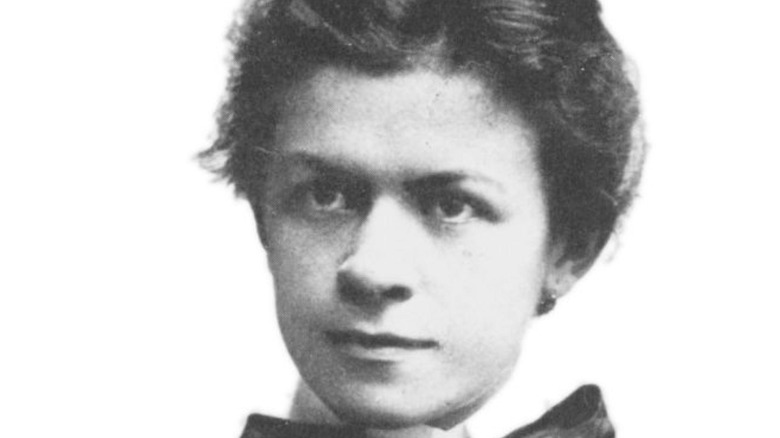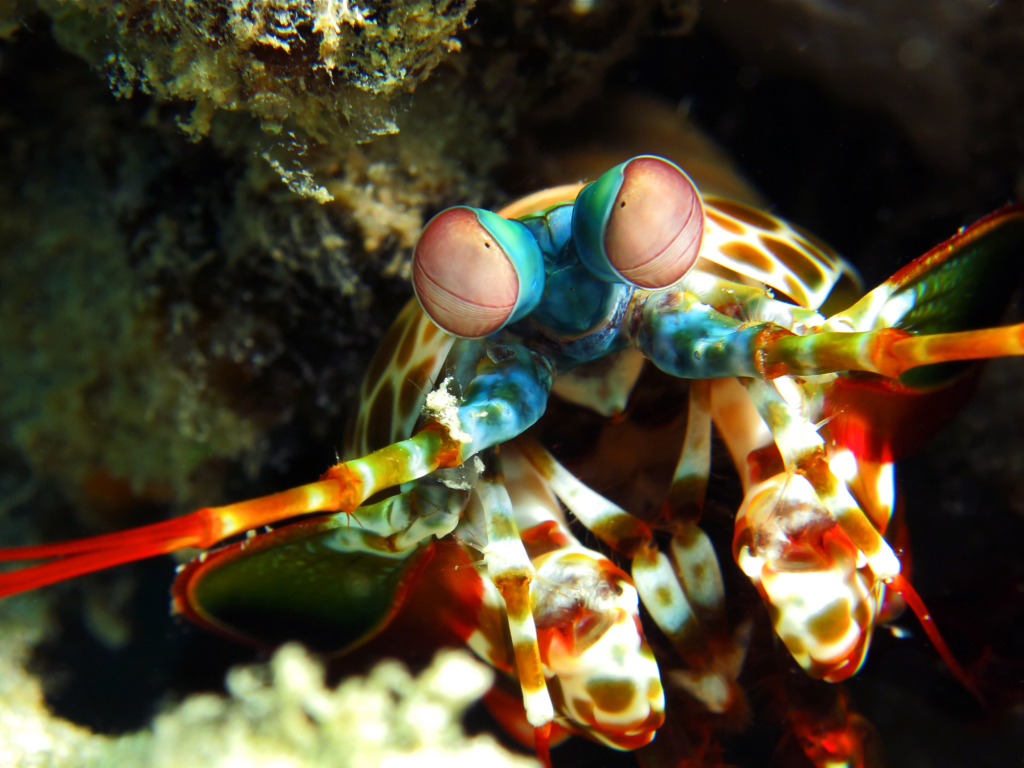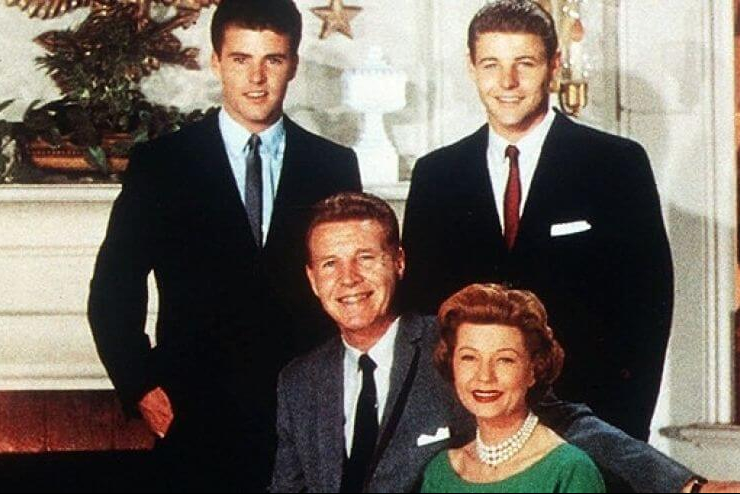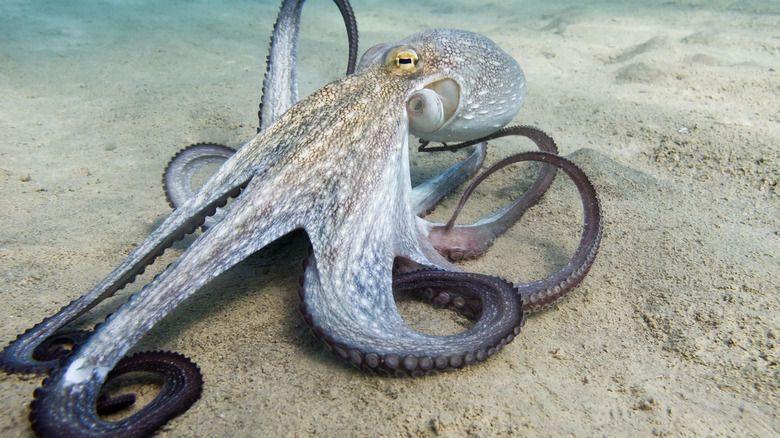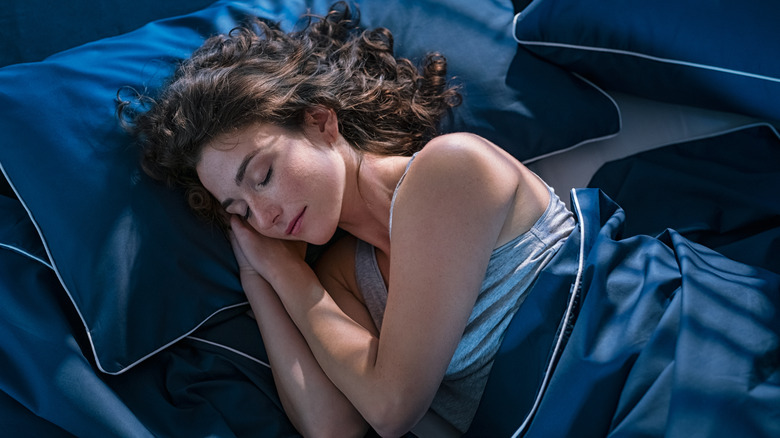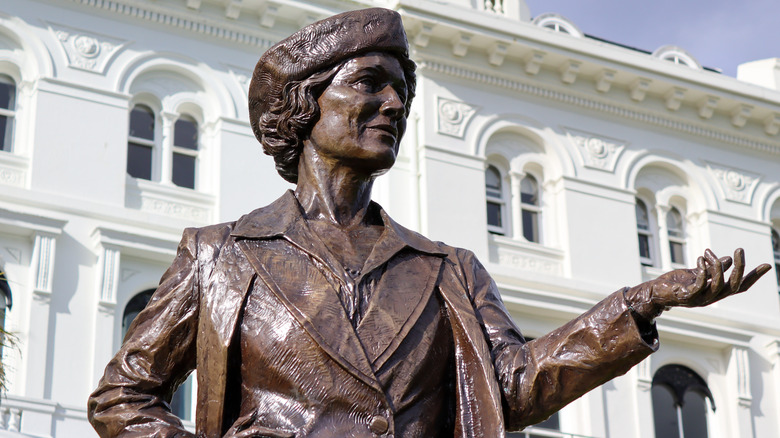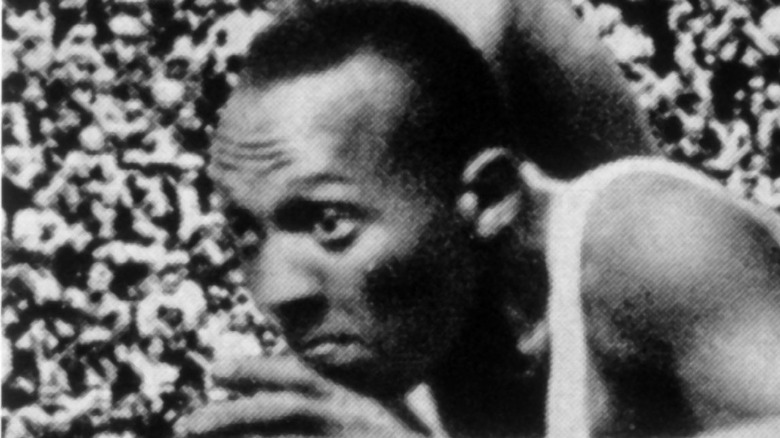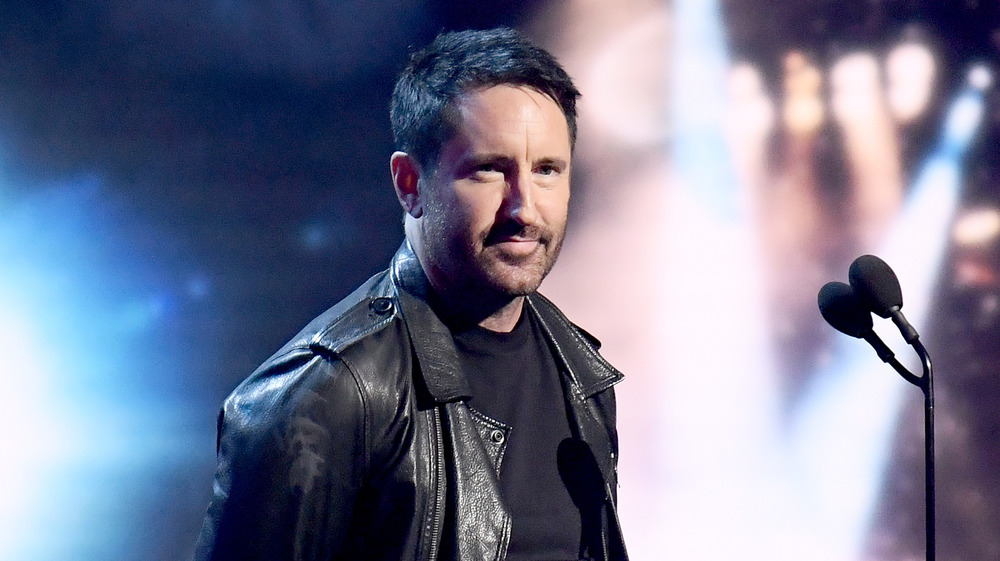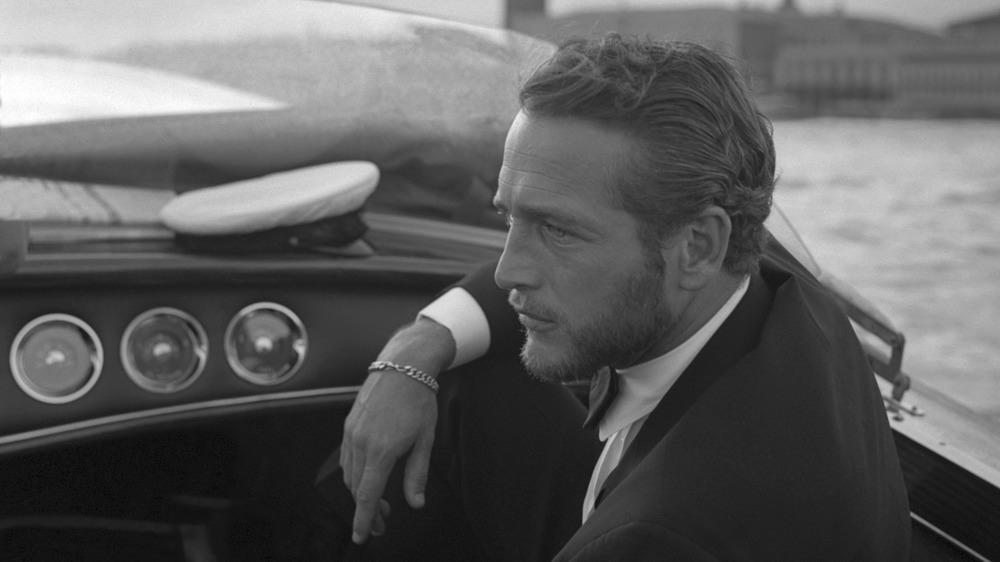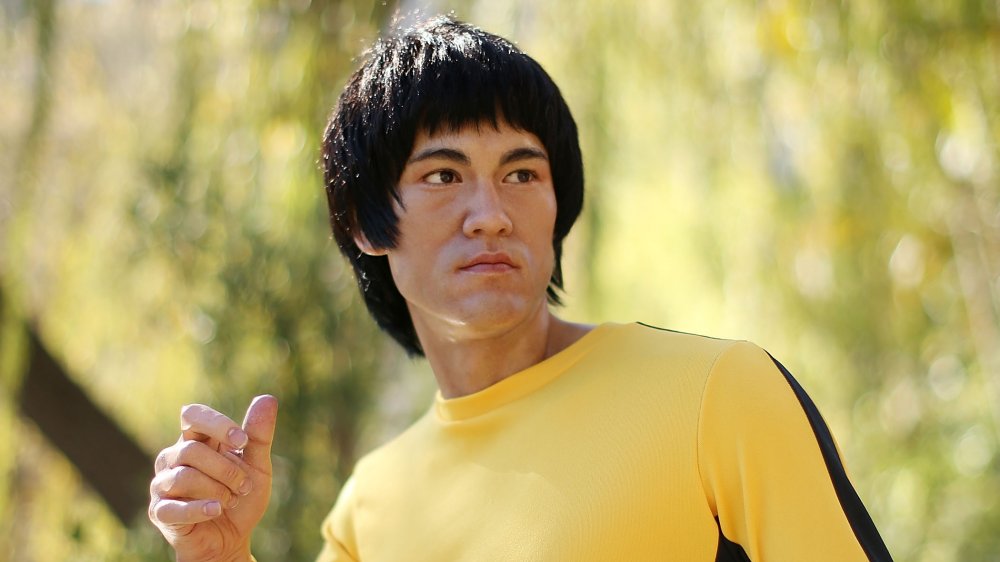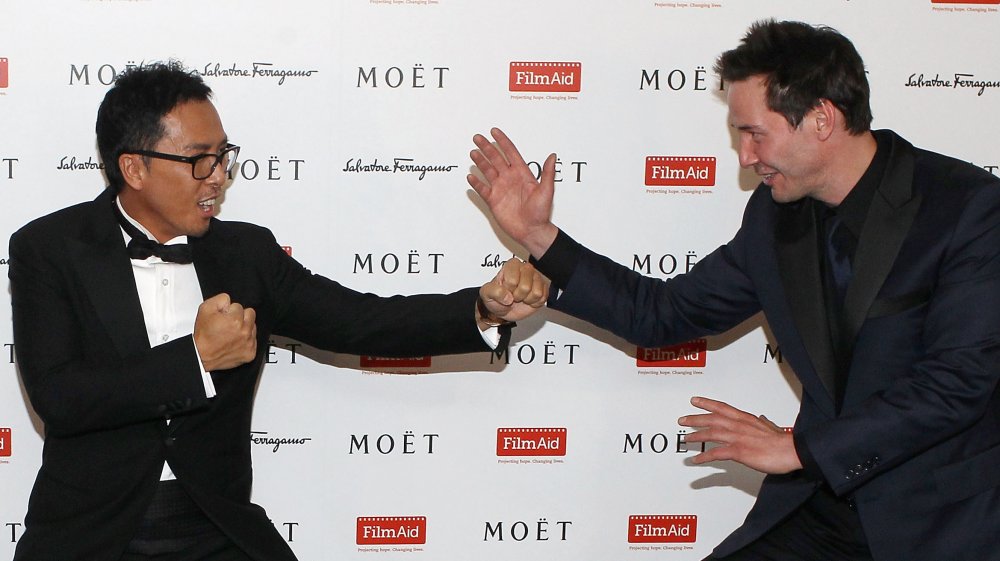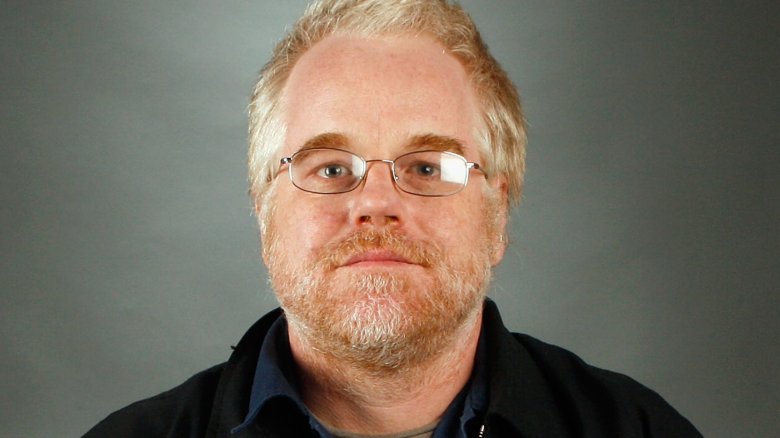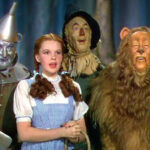
The Dark Side You Never Knew About The Wizard of Oz
The Wizard of Oz has remained a classic American film since its creation in 1939. The film’s star, Judy Garland, was launched into the stratosphere of Hollywood stardom, and promised her a long career as a Hollywood actress.
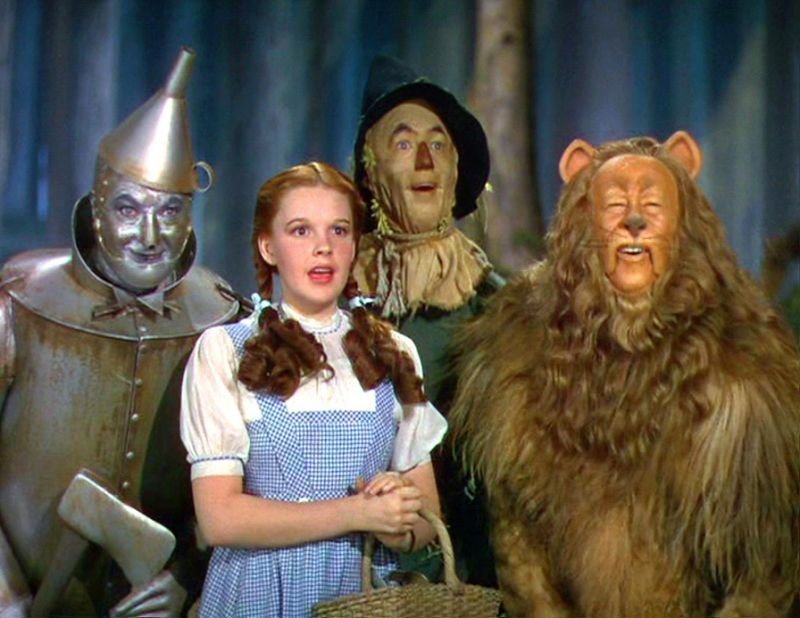
The Wizard of Oz is famous for its unprecedented and innovative Technicolor and beautiful set pieces. But like most masterful creations, things weren’t always smooth sailing on set. Read on to discover the behind-the-scene scoop about this Classic film.
The Movie’s Most Famous Song Almost Didn’t Make The Final Cut
The soundtrack for the Wizard of Oz produced one of the most memorable songs of our time, “Over the Rainbow.” But that beautiful ballad was almost cut from the film. The original cut of the film has a run-time that the studio found unacceptable. Producers insisted that the two hour run time be cut down by 20 minutes at least so the length would be reasonable for audiences to sit through. One of the original cuts was the “Over the Rainbow” song, since producers believed that all the black and white scenes slowed down the picture, and younger audience members would have no interest in the message of the song. In the end the song did get cut, but it was the reprise filmed in the Wicked Witch’s castle rather than the opening black and white version with Dorothy. And the rest is movie history.
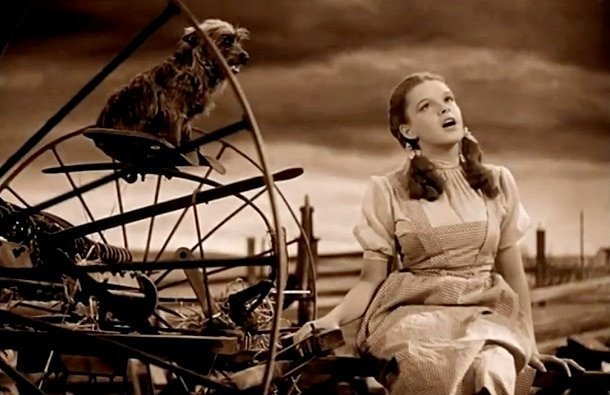
In the end the song did get cut, but it was the reprise filmed in the Wicked Witch’s castle rather than the opening black and white version with Dorothy. And the rest is movie history.
Dorothy Was Supposed To Be Blonde
Victor Fleming was not the original director of the film. The original director was a man named Richard Thorpe. He had envisioned a film that resembled the book much more closely. He wanted a Dorothy that looked like the illustrations of John R. Neill. In the original illustrations Dorothy is blonde. Thorpe wanted his and sporting a face of baby doll styled makeup.
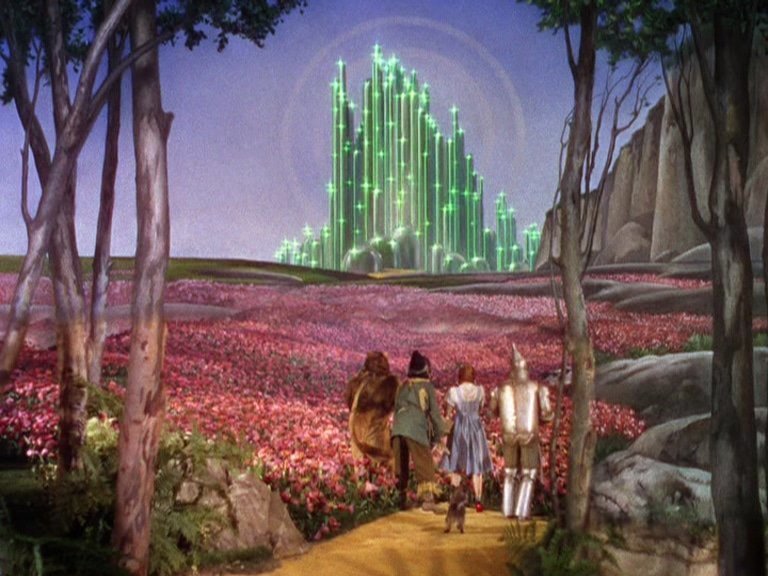
Thorpe did not cast Judy Garland in his film. He was hoping he would be able to cast the young blonde star, Shirley Temple. He also cast a different actor for the Tin Man, Buddy Ebsen of “Beverly Hillbillies” fame. His vision didn’t matter much in the end because Thorpe’s tenure on the film lasted for only two weeks.
Judy Garland Almost Didn’t Get The Lead Role
Many years later, it is almost impossible to imagine The Wizard of Oz without Judy Garland. MGM Studio executives always had her in mind, but she wasn’t at the top of their lists. Everyone thought the blonde star, Shirley Temple, would be a better casting decision. She was younger than Garland and a much bigger star at the time. However, despite her baby doll looks and successful filmography, no one was sure that she had the singing voice necessary to make the movie successful.
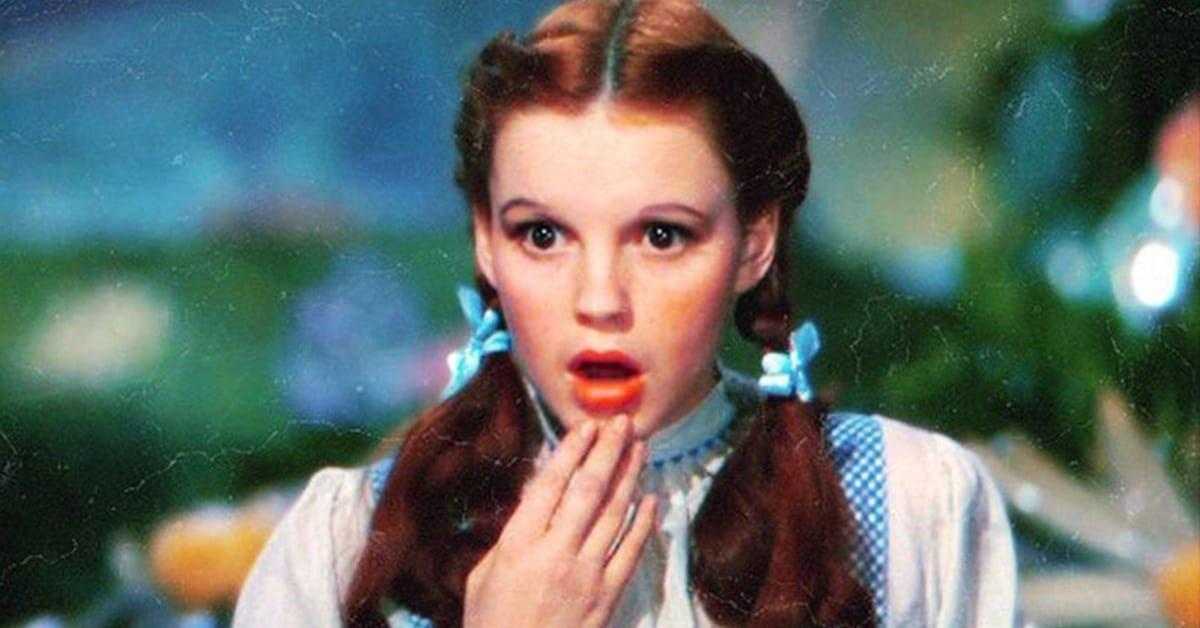
In the end it was the studio system itself that sealed both actresses’ fates. Shirley Temple was contracted to 20th Century Fox at the time. MGM offered to trade both Clark Gable and Jean Harlow’s contracts to secure Shirley Temple but when Jean Harlow died unexpectedly the deal fell through. The studio system itself may have led to Harlow’s untimely death. It has been implied that the hair dye the star used may have caused her death from liver failure.
Who Really Came Up With Dorothy’s “Look”?
Before Victor Fleming came onto the project, but after Richard Thorpe had departed, George Cukor was at the project’s helm. At the time Cukor was angling to be hired as director for “Gone with the Wind,” and never intended to finish the Wizard of Oz. In the end Cukor lost both The Wizard of Oz and the Gone with the Wind jobs to the same man, Victor Fleming.
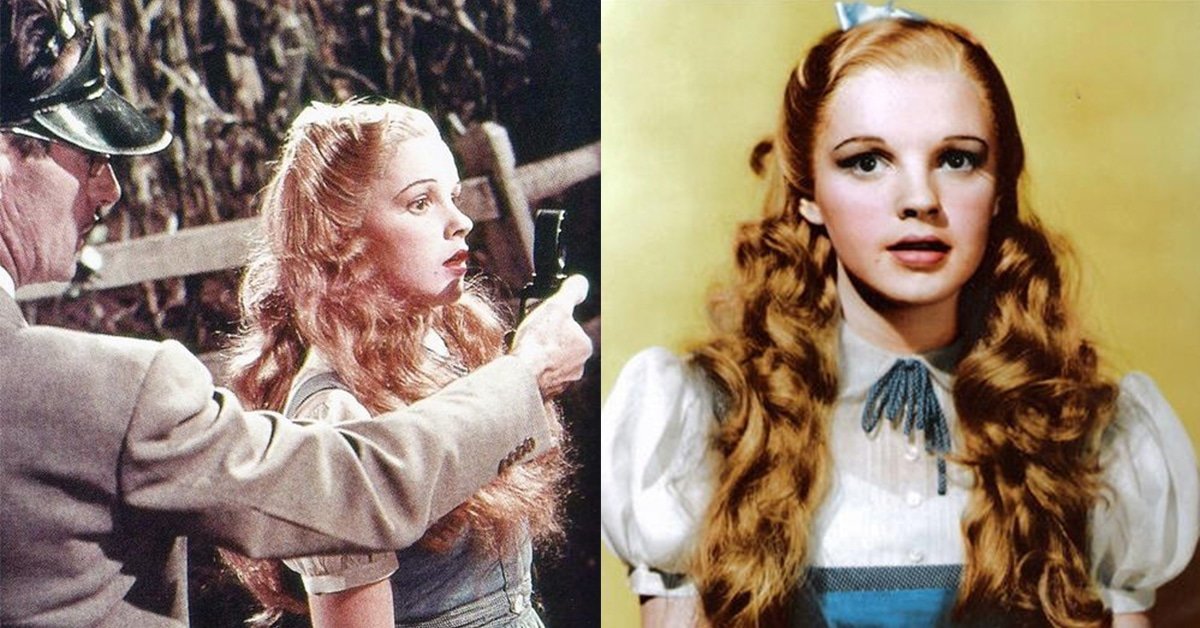
However, it was during Cukor’s time on the picture that Dorothy’s iconic look came to be. He rid the production of any thought of blonde wigs or dye and insisted on a “natural” look for the Kansas farm girl. He wanted her looks to contrast the fantastical Technicolor style of the rest of Oz.
Playing The Tin Man Was Quite The Hassle
No one had any luck, it seems, when it came to being cast as the Tin Man. Jack Haley was not poisoned as his predecessor, Buddy Ebsen, but it was not an easy assignment. While Haley did not have breathing problems, or have to spend two weeks in a hospital, he did contract an eye infection from all the makeup he was forced to use.
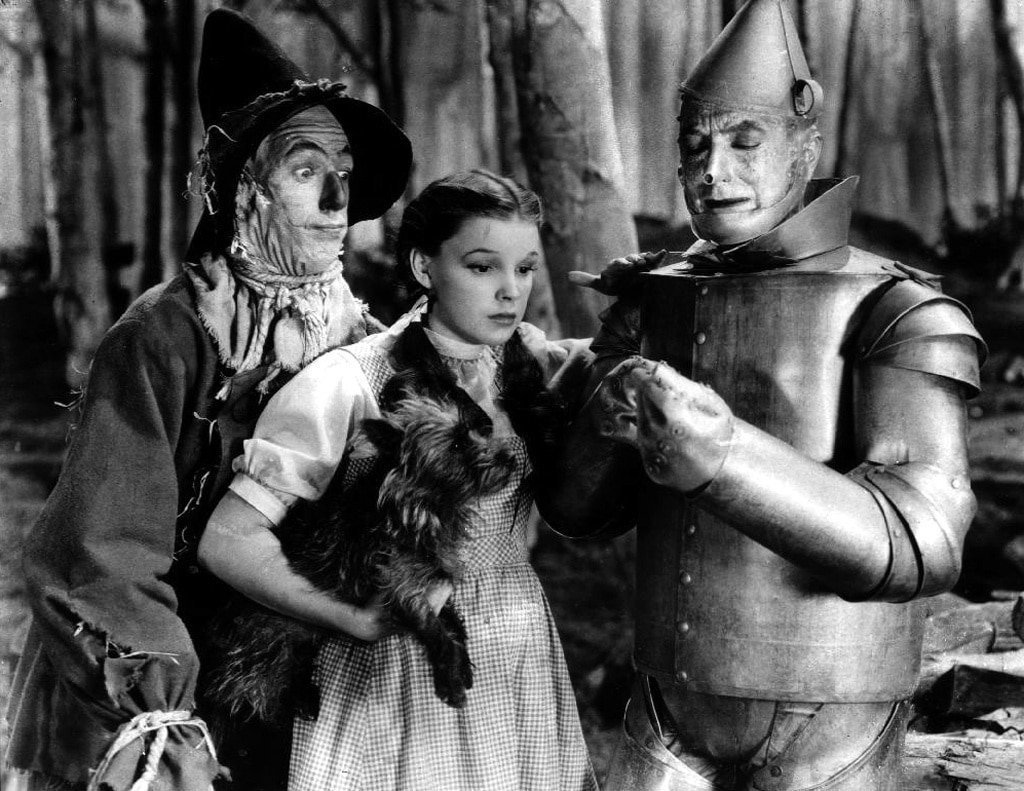
The Tin Man costume itself was very stiff and awkward to move around in. It was impossible for Jack Haley to rest or relax while dressed for his part; there was no way to sit down while in character. If Haley decided to lay down on the ground, it was then impossible for him to stand up again without assistance from the cast and crew. The only relief he was able to find was by leaning up against walls or pillars to take some of the weight off his feet. Otherwise, he was standing the entire time he was in costume.
The Lion Costume Was Made From Real Lion Fur!
The costume for the Cowardly Lion is something to behold. If a man and a lion had a baby, odds are, it would look something like Bert Lahr did in The Wizard of Oz. This makes even more sense when you realize that a large portion of Lahr’s costume is in fact made from the pelts of real lions. The look was great but, like the saga of the Tin Man, there were struggles involved. The costume, and its real lion pelts, weighed almost 50 pounds.
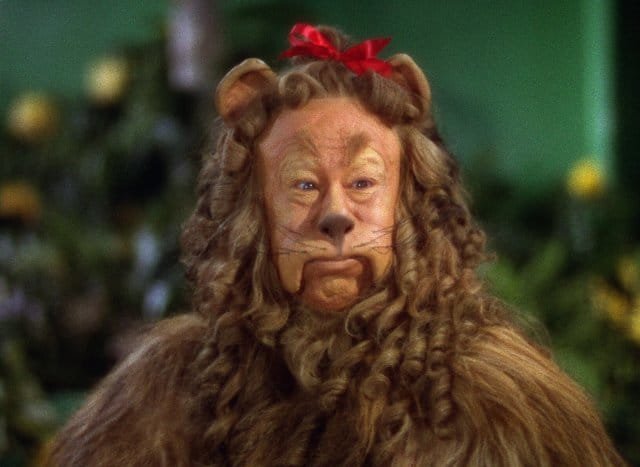
Early on there were rumors the MGM actually wanted to use a real lion, their famous mascot Jackie, from their logo, to play at least a small part of the role, but in the end, other than the pelts, the part was all human. Bert Lahr’s humor and warmth would not have been a part of the character, or even possible, had an actual lion been cast in his place.
Toto Had A Nice Salary For A Dog Actor
Toto was played by a female Cairn terrier named Terry. Terry made appearances in 16 films throughout her career, her most impressive performance being The Wizard of Oz. Before being cast as Toto, Terry starred alongside Shirley Temple in “Bright Eyes.”
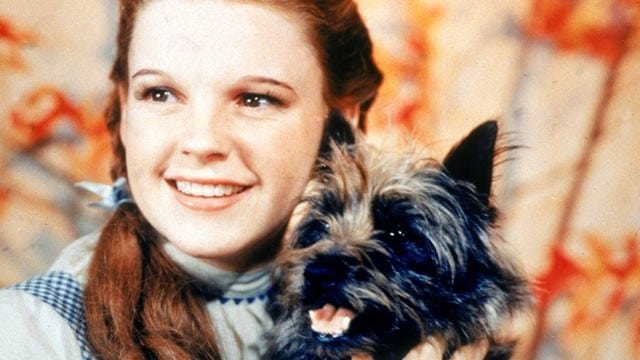
Her experience led to the canine earning more than some of the human actors cast in the film – all of the munchkins included. Terry earned $125 a week on the film, which would be over $1,500 a week today. Actors cast to play the munchkins made only between $50 and $100 a week. It was good money at the time, but still not the movie star money Terry was making as Toto.
The Transformation Of The Wicked Witch
Not everyone judges a book by its cover, and it’s no different with characters. While the Wicked Witch of the West today is an icon with her black hat and green complexion today, that wasn’t always her signature style. Originally the concept for the Wicked Witch gave her a much more sleek and sexy style. Producers however, concerned with making her appear convincingly evil and cruel changed her look before filming. They needed her to contrast much more sharply with the look of Glinda the Good Witch.
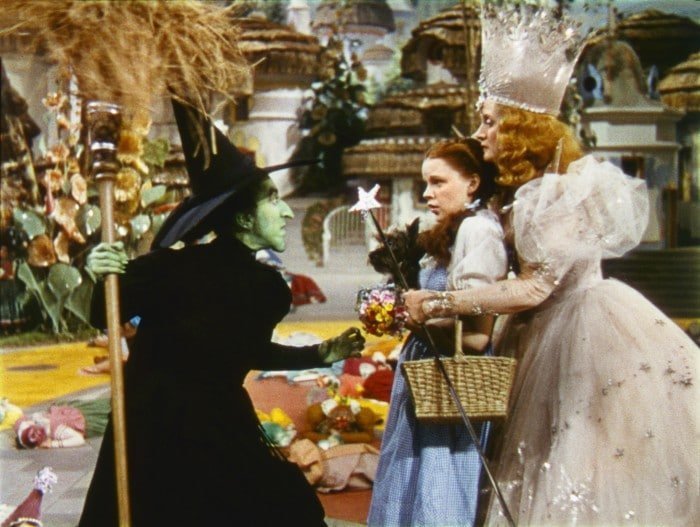
The look wasn’t the only thing that changed but, like the Tin Man, the Wicked Witch also had to be recast. Gale Sondergaard was originally hired to play the Wicked Witch but, upon learning of the change to the look and makeup, stepped away from the project. Margaret Hamilton stepped in to take Sondergaard’s place.
The Witch Was Too Wicked For The Big Screen
Margaret Hamilton’s casting, and the new black and green look, worked so well that the character took on a life of her own. Have you seen the musical or read the book “Wicked”? However, Hamilton inhabited the character so well she took away from the “light hearted” family adventure producers hoped the film would be.
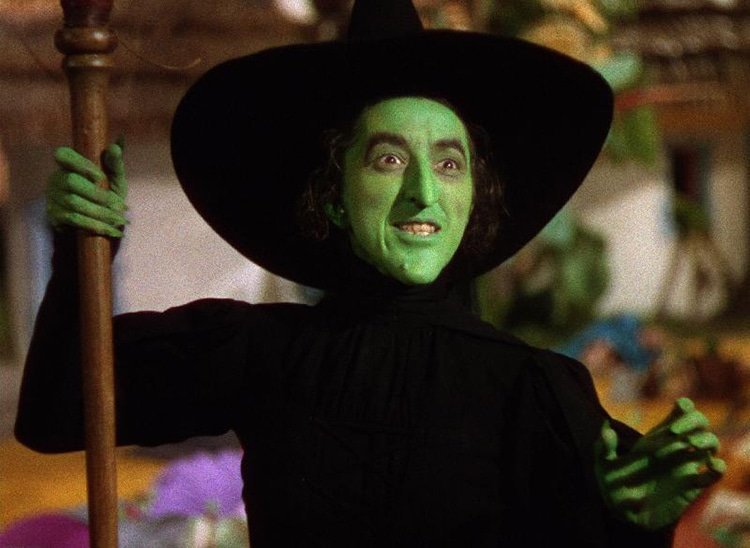
Hamilton’s performance, they feared, was just a little bit too scary for a children’s audience. Rather than recasting again, executives cut down the scenes in which Hamilton appeared. Despite losing some screen time, Hamilton’s presence was no less strong in the film, or as part of the movie’s legacy.
Margaret Hamilton Got Injured During The Action
Producers may have cut some of Margaret Hamilton’s scenes, but that was far from the worst thing that happened to the actress on the project. Hamilton, like Ebsen before her, was injured on set and was absent for a full six weeks of filming.
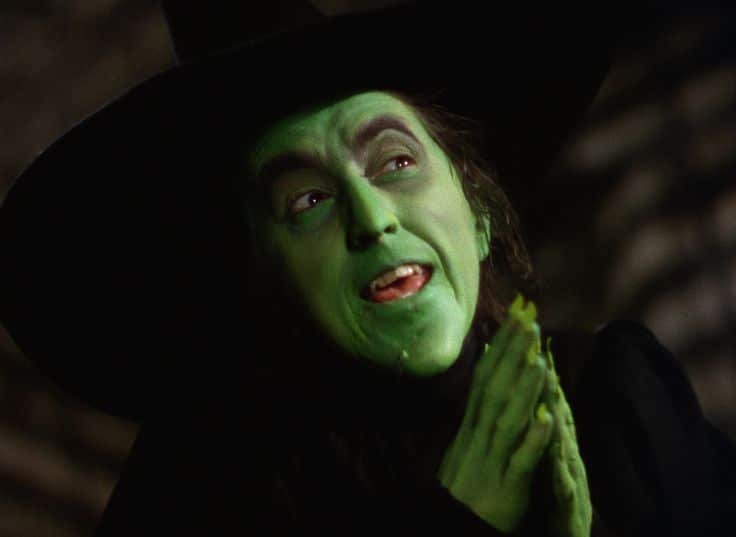
During the Wicked Witch’s first appearance in the movie, where she appears in Munchkinlan. Hamilton was actually burned just as she was supposed to disappear in a puff of smoke and flames. The stunt was designed to drop the actress safely through a trap door before any flames appeared, however, due to a malfunction, the door did not open quick enough, though the flames appeared right on cue. The actress was left with burns on her hands and face.
The Movie Is Always Different From The Book
Movies that are adapted from novels will always contain changes and edits. However, lovers of the Frank Baum original were not expecting to find quite so many changes from their beloved book in the beloved MGM film. Some changes were small, like names. In the book, Glinda is the Good Witch of the South, rather than the Good Witch of the North, as she is in the movie. But some changes were much larger than that. For instance, in the book, Oz is a real place. In the film the story, and Oz itself, is portrayed as a dream Dorothy had.
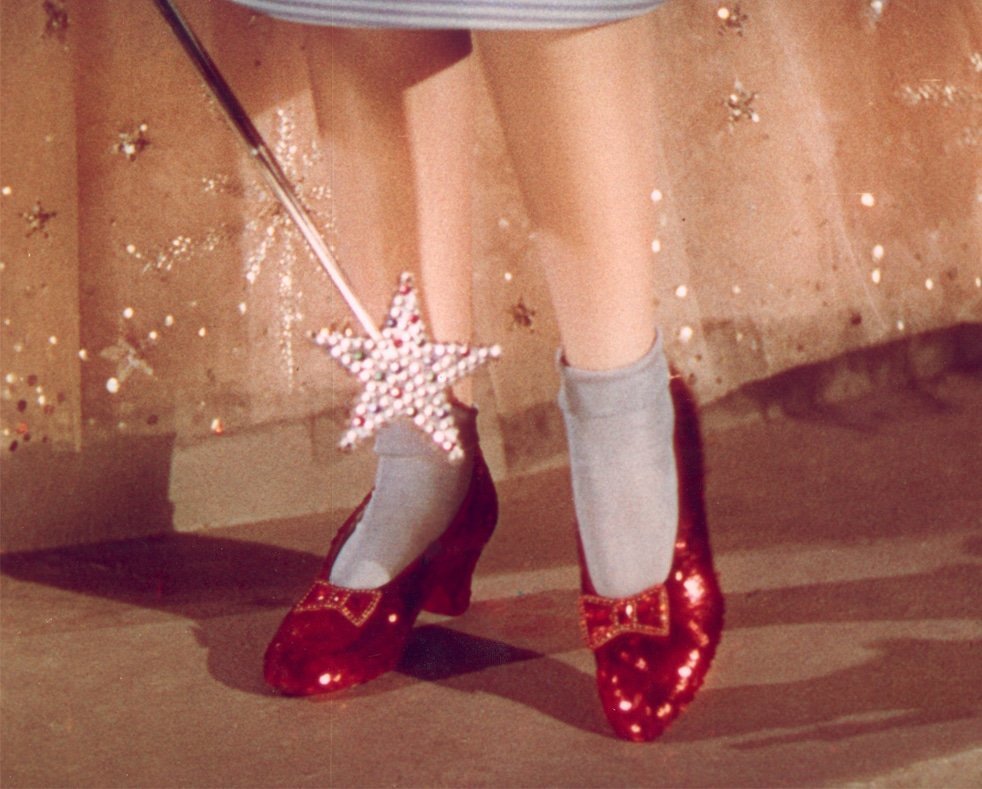
The most well known change has to do with one of the film’s most well known symbols. In The Wizard of Oz on screen, Dorothy has red ruby slippers. In the Frank Baum original, Dorothy has silver slippers. It was studio head Louis B. Mayer, who insisted on the change. Wanting to test out the company’s new Technicolor technology, he insisted that they use a brighter and more vibrant color than silver, as described in the book. In other fun Technicolor facts, Dorothy’s dress on set was not white and blue, but pink and blue, so it would be easier to shoot with the Technicolor cameras.
Don’t Scare The Crew!
Ray Bolder, who played the Scarecrow, Bert Lahr, who played the Lion, and Jack Haley, who played the Tin Man, wore costumes that were both very lifelike, and very hard to get on and off. Between takes, and during lunchtime, they often had to rest and eat in costume. In the 1930’s cast, crew, and other employees on the MGM lot were not particularly used to horror movies or realistic special effects.

This meant that the Scarecrow, the Cowardly Lion, and the Tin Man were banned from eating in the regular MGM lunchroom, reportedly, so they wouldn’t scare other staff members. They had to eat alone, something that is all but unimaginable in today’s selfie and celebrity obsessed culture.
The Original Dorothy Gale Wasn’t A Damsel In Distress
In the Wizard of Oz, Judy Garland plays Dorothy Gale as very much your standard damsel in distress. She is always being thrown about, captured, and in need of help. In the book, blonde Dorothy with her silver slippers is very different. Oz, as a real land rather than a dream, is a world where Dorothy finds she fits in as a strong and self-assured character.
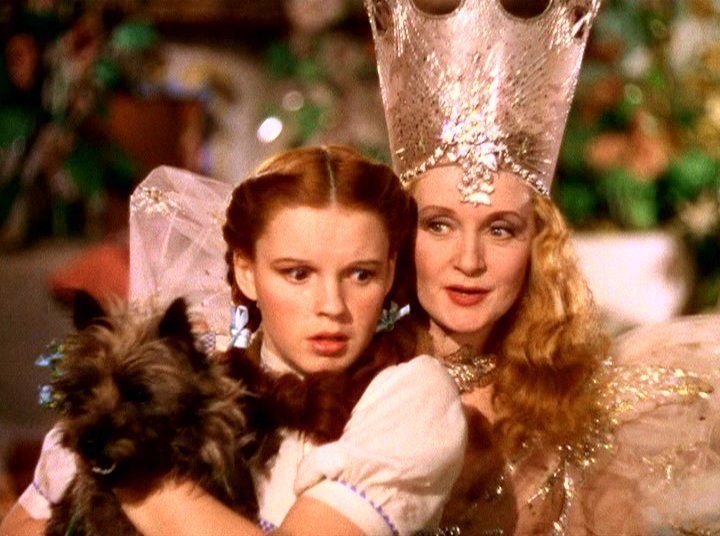
In the novel, it is Dorothy who saves other characters, rather than depending on them to come to her aid. Baum has actually admitted to writing Dorothy as a strong role model for his young female readers.
Consistently Inconsistent
Working with Technicolor meant the crew had to work with a crazy amount of lighting on set. All those lights kept the set at nearly 100 degrees. If you watch very carefully you can even see reflections from all of the lights on set pieces throughout the film. Just watch the floor of Emerald City as it rolls by.
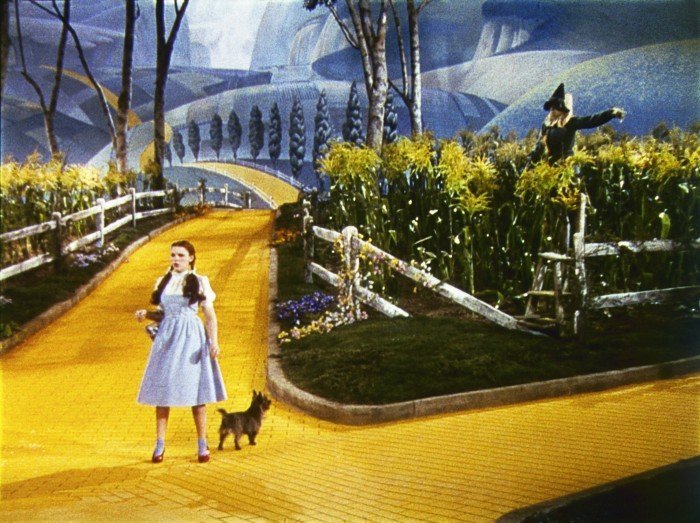
That’s not the only thing to watch in the 1939 masterpiece. Dorothy’s hair can be seen to change lengths throughout the picture. Props come and go as if by magic including the Tin Man’s spear that turned into an ax, and the bouquet the munchkins give Dorothy upon her arrival in Oz that subsequently disappears. Logically we should also question a witch who can be killed by water living in a castle surrounded by a mote. Honestly, why does she keep buckets of water around at all?
L. Frank Baum’s Coat Made An Appearance In The Movie
Frank Morgan was cast not only as the Wizard of Oz but also as Professor Marvel, who Dorothy runs into when running away in Kansas. Costume designers worked very hard to find the actor, just the right coat for his two characters. They wanted Morgan to look fashionable, but also modest. They went searching through local thrift stores for the perfect style. They found it.
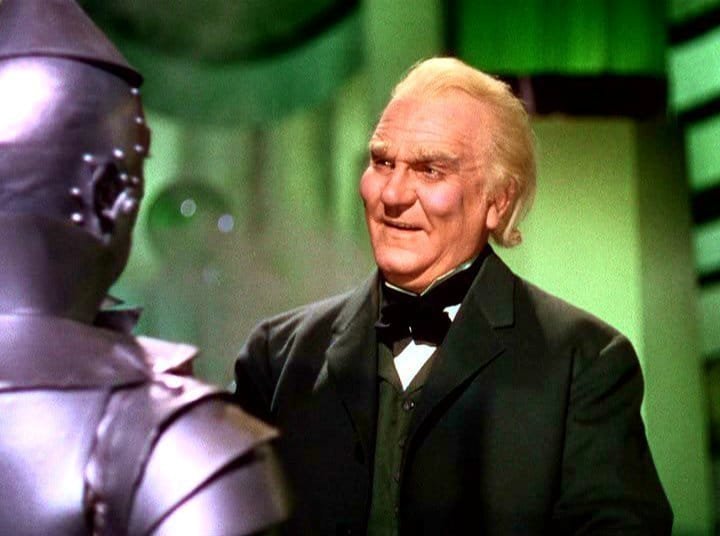
When they passed off the coat to Morgan he examined it before putting it on and found a label, stitched to the coat’s interior that read, “L. Frank Baum.” It was indeed the original author’s coat, and had, back in the day, been tailored to fit him perfectly. After production on the film was complete, the producers gave the coat to L. Frank Baum’s widow to keep.
Munchkins Rumors Debunked
While we all love some good Hollywood trivia, one story about the Wizard of Oz set that has persisted throughout the years, was that a munchkin hung himself on set and, this instance was actually caught on film for the movie. There was not a single suicide on set, by cast or crew. Conspiracy theorists claim you can see someone hanging from a tree, but itis actually just a bird.
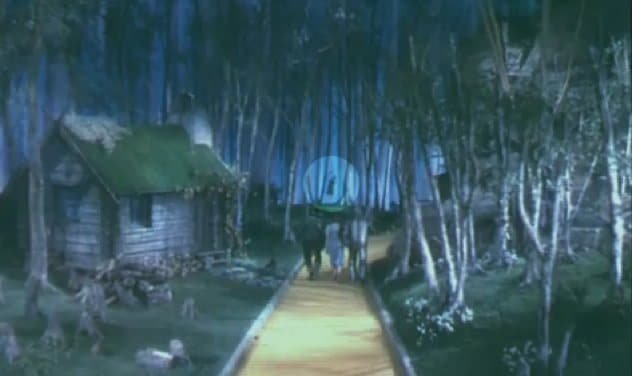
It’s a real bird too. MGM had rented, from a local zoo that they’d worked with on previous projects, some 400 birds. Many of the birds escaped their cages while working and ended up hanging out in random places around the set. The bird in the “suicide” scene is actually a crane with its wings outstretched.
The Original Tin Man Was Poisoned By The Makeup
Beverly Hillbillies, Buddy Ebsen, spent almost as little time on set as both the film’s first two directors. Ebsen was accidentally poisoned by his own makeup a little over a week before filming was set to begin. The silver makeup, a main staple of the Tin Man’s costume, was made partly of aluminum dust, which Ebsen breathed in, due to its presence on the entirety of his face. He was hospitalized when his lungs failed.
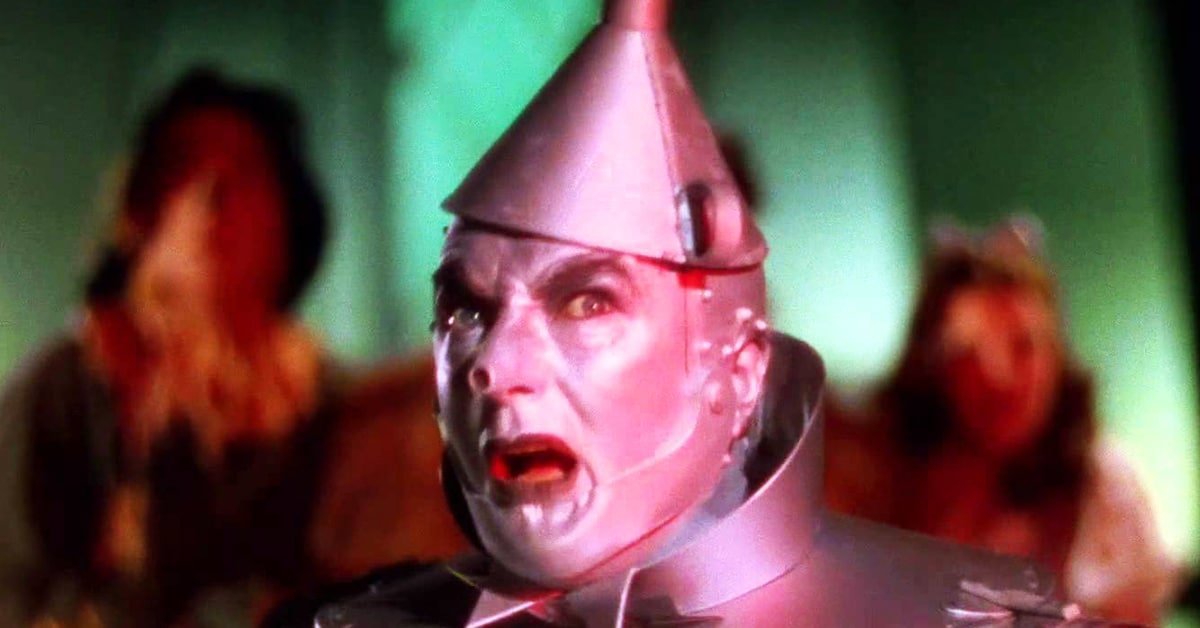
After two weeks in the hospital it still took six more weeks of rest at home for the actor to recover. It turned out that Ebsen was actually allergic to the aluminum dust, and was recast by Jack Haley, who did not have the same allergy. However, to avoid any other possible mishaps, an aluminum paste replaced the original aluminum powder makeup. Better safe than sorry.
Why Shirley Temple?
Shirley Temple was the darling of American film in the 1930’s. She starred in everything: The Little Princess, Heidi, Rebecca of Sunnybrook Farm, to name only a few. She was a paparazzi princess. Her photos and her off set antics were in all of the magazines. There is even a photo where you can see the Wizard of Oz book on one of the pint sized star’s own bookshelves.
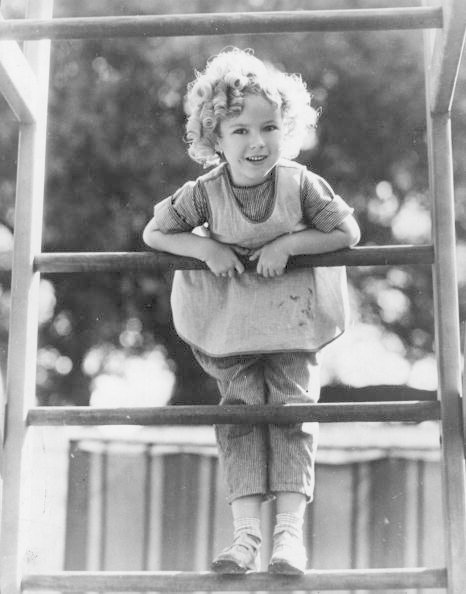
She was also blonde, the very image of the Dorothy from the books. It was really no wonder producers went after her for the part when they began casting The Wizard of Oz film.
Arthur Freed Voted For Garland
In Hollywood Arthur Freed was a legendary producer and lyricist. He was never credited with any work on The Wizard of Oz film, but he did receive a promotion from MGM for his contributions. This promotion eventually led to his first credit with Rodgers and Hart’s Broadway musical, Babes in Arms, which also starred The Wizard of Oz’s, Judy Garland, along with Mickey Rooney. The trio of Freed, Garland, and Rooney would work together on a number of successful “backyard” musicals throughout their careers.
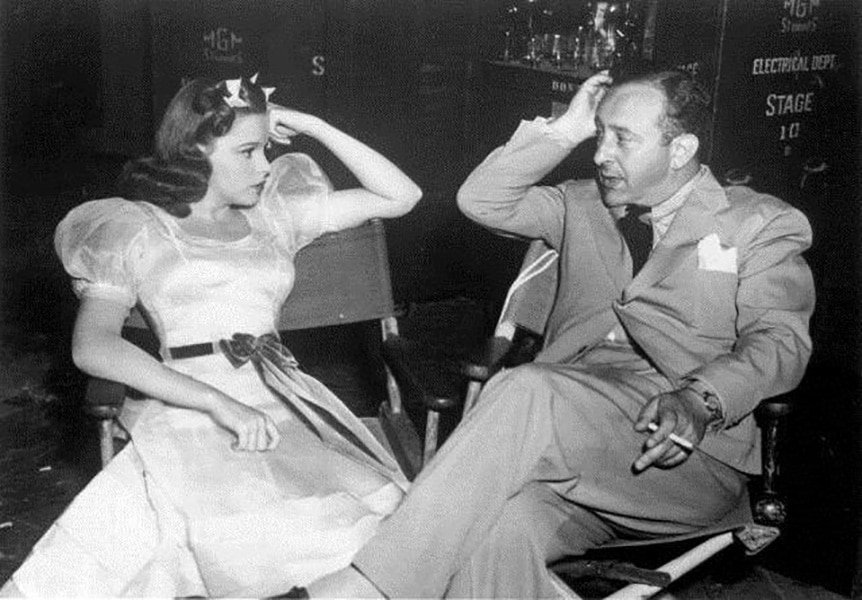
While Louis B Mayer voted for Shirley Temple for the role, Freed insisted that Judy Garland, with her singing chops, she was a much better choice.
Judy Garland As Dorothy Gale
It may seem lucky that Judy Garland, despite being the studio’s second choice, got the role of Dorothy Gale, but we never really know the effect our experiences and opportunities will have on us until much farther down the road. Beyond being forced to take drugs while on set Garland was also made to wear a corset for the part. At 16 she was a teenager, her body and her life were changing. Despite everything the studio also insisted she lose another 12 pounds.
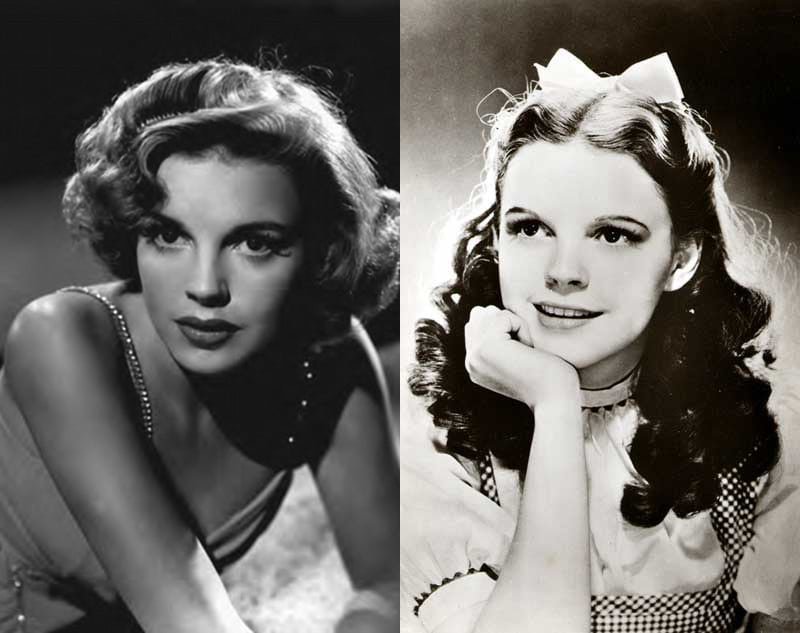
The Wizard of Oz may have solidified Garland as a bonafide Hollywood star, but the continued evidence of abuse and exploitation she suffered continues to haunt her legacy, as well as that of MGM studios, all these years later. How, as a teenager in the public spotlight, could she ever be expected to recover from the comments about her weight, and the constant demands that she improve her appearance by men many times her own age? Garland once said of herself, “I was frightful. I was fat – a fat little pig in pigtails.” MGM worked to build her public image, but never once considered her self-esteem.
The Famous Dress
Dorothy Gale’s blue and white gingham dress is one of the most recognizable costumes in Hollywood history. Beyond its look, the dress was designed with particular pockets for use in very specific scenes. In the seam of the skirt, for instance, there is a hidden pocket that held the handkerchief that Dorothy uses to wife away the Cowardly Lion’s tears on screen.
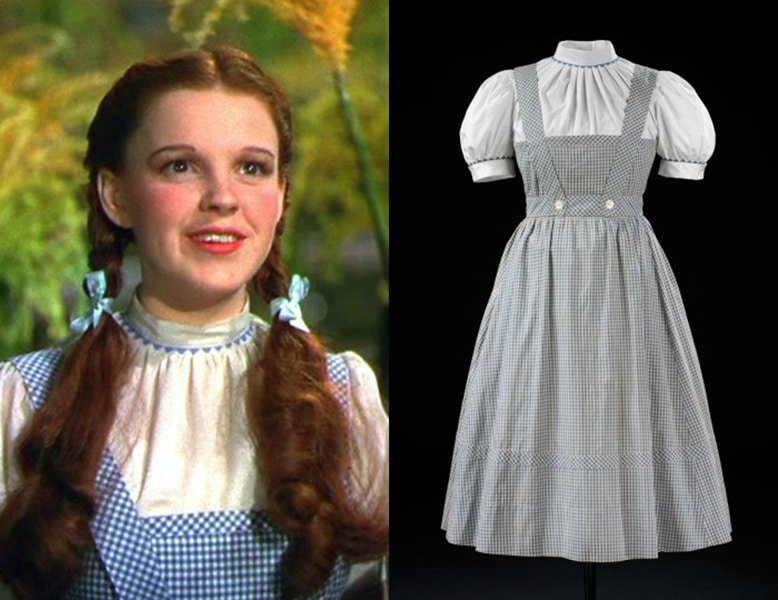
Being one of the most recognizable costumes in the history of Hollywood certainly paid off when the dress itself went up for auction in November of 2012. The single blue checkered gingham dress fetched nearly half a million dollars at auction.
Margaret Hamilton As The Wicked Witch Of The West
Margaret Hamilton will always be most recognized for her roll as the Wicket Witch of the West in The Wizard of Oz. However, before being cast in the blockbuster, she lived a quiet life as a schoolteacher and character actress. She’d never done anything like playing the green meanie in the MGM Technicolor fantasy. The Wicked Witch remains a classic movie villain, recognizable all overthe world over. Hamilton will always be remembered for her role as one of the top 5 movie villains of all time.
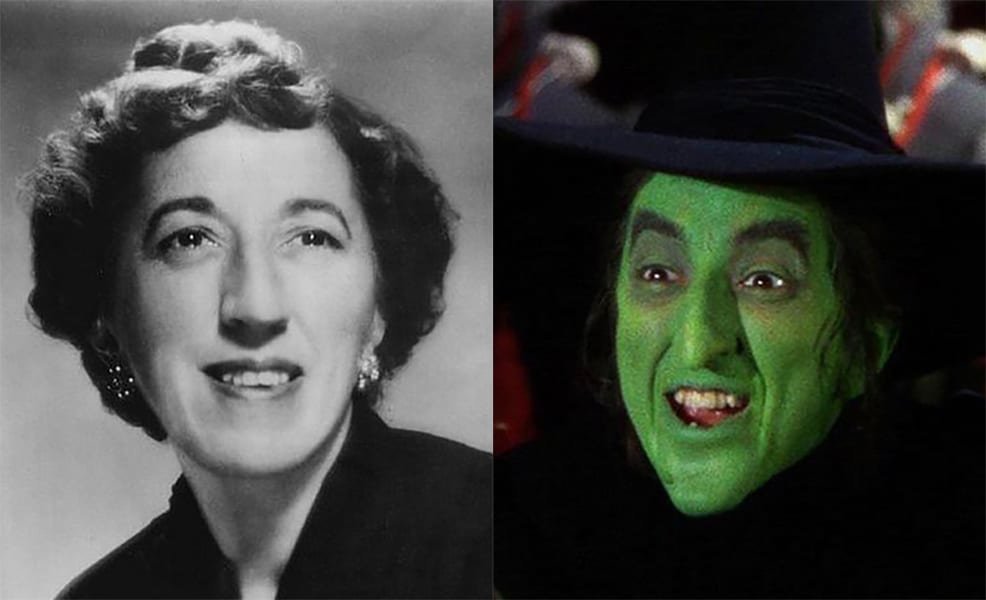
Despite her evil doppelganger on film, Margaret Hamilton was actually very active in causes connected to the welfare of children and animals, and was a very prominent advocate for public education.
What About The Wicked Witch’s Sickness?
While we’ve covered Buddy Ebsen and his unfortunate allergy to the silver powder makeup of his character, the Tin Man, the Wicked Witch also struggled with the green makeup she was made to wear for the film.
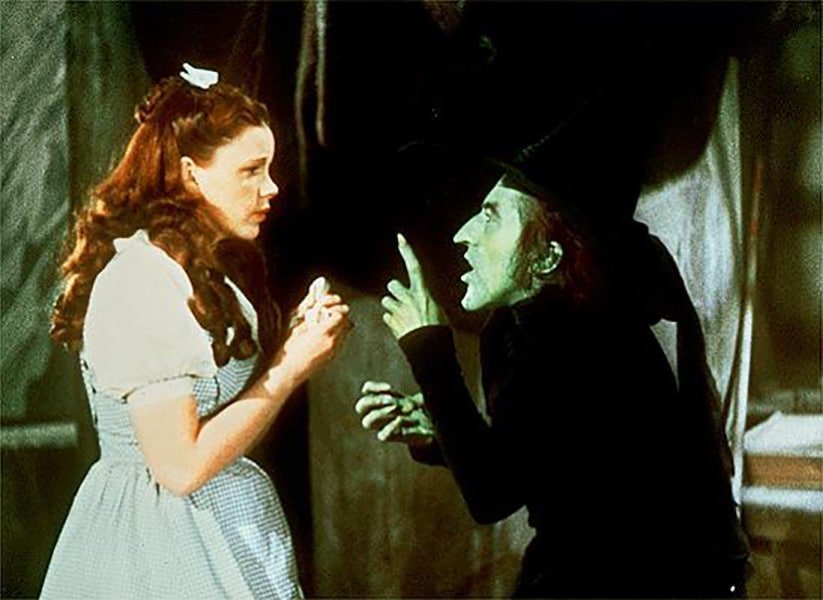
The Wicked Witch’s makeup was in fact toxic. At one point, Mitchell accidentally swallowed some of her green makeup and got so sick she was on a liquid diet for quite a number of days. The makeup was made with copper-based ingredients that made it very very difficult to remove. Hamilton’s face remained tinged with green for weeks after filming of the picture had officially ended.
Poor Puppy
The set of The Wizard of Oz was fraught with dangers for the entirety of its cast, and not just the human actors who worked there. Terry, the Cairn terrier who played Toto also suffered an injury while working. While Terry fit perfectly in Judy Garland’s prop basket, she was not carried about for the entirety of filming.
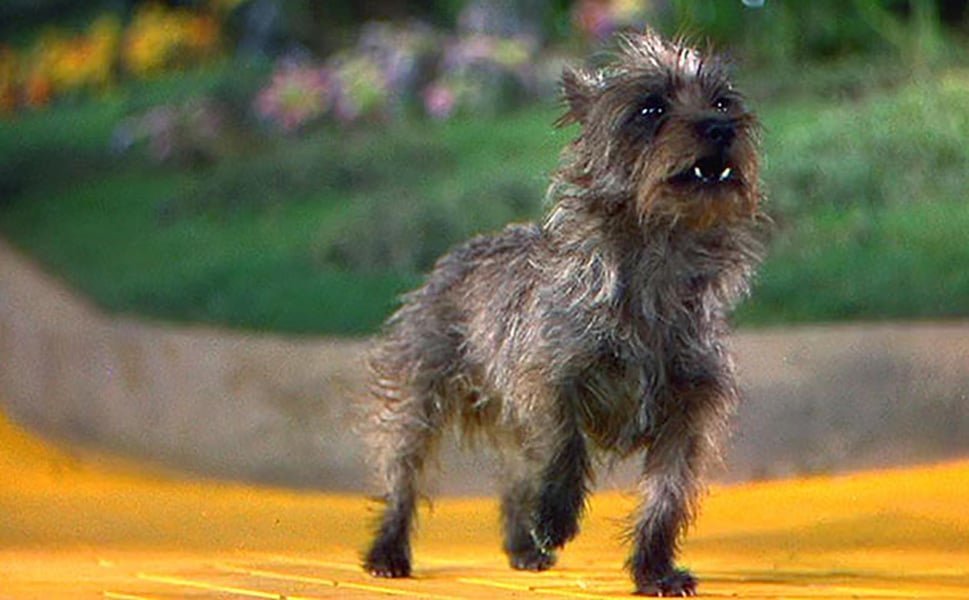
When roaming around out of the basket the poor tiny puppy had her paw trod on by one of the Wicket Witch’s guardsmen. The paw was soon deemed broken. Terry, our famous Toto, did recover and go on to star in over 15 films.
The Yellow Brick Road
The Yellow Brick Road, unlike the Silver Slippers of the original book, was translated as described to the screen. It is one of the most iconic images from either Baum’s book or MGM’s movie. Sometimes, however, things are a bit clearer in the imagination. Due to MGM’s insistence on using Technicolor industrial-grade paint had to be brought in to repaint the yellow on the set.
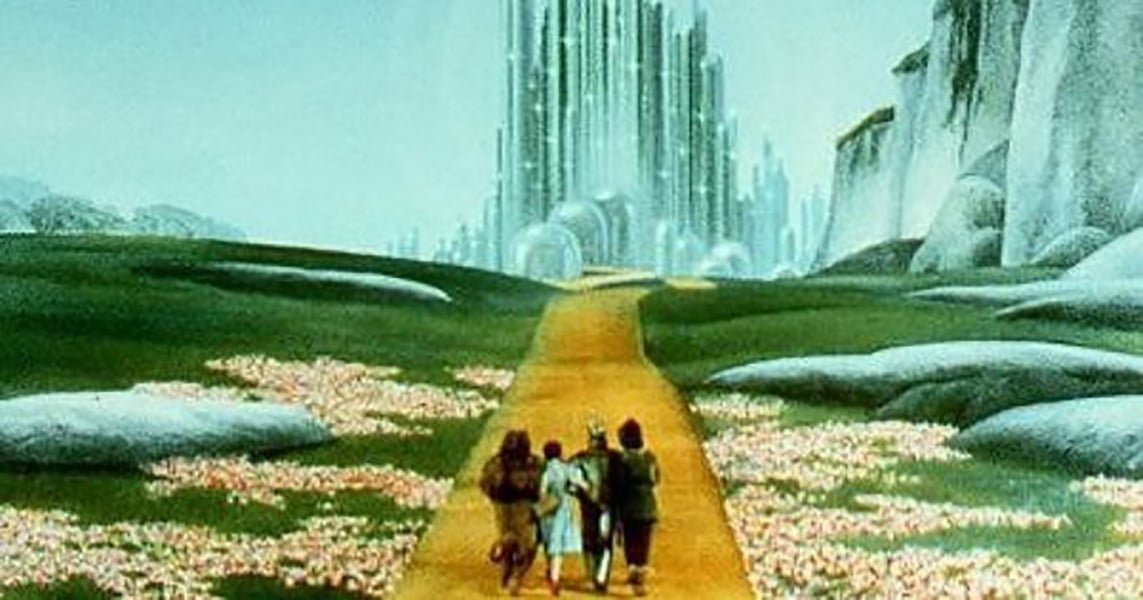
In Technicolor the original road came through with a green tint on camera. While clear in his colorful description Baum could not have imagined the trouble his colorful world would give 20th century moviemakers.
Ray Bolger As The Scarecrow
Ray Bolger was the actor who took on the portrayal of the brave but brainless Scarecrow in the MGM version of The Wizard of Oz. Like Judy Garland, it is the movie he is best remembered for today. Also like Garland, and many of his costars, he was also plagued with the negative after-effects of his participation in the project. The mask Bolger wore for his portrayal, while not as dangerous as the Tin Man makeup, did leave its own lasting impression on the actor.
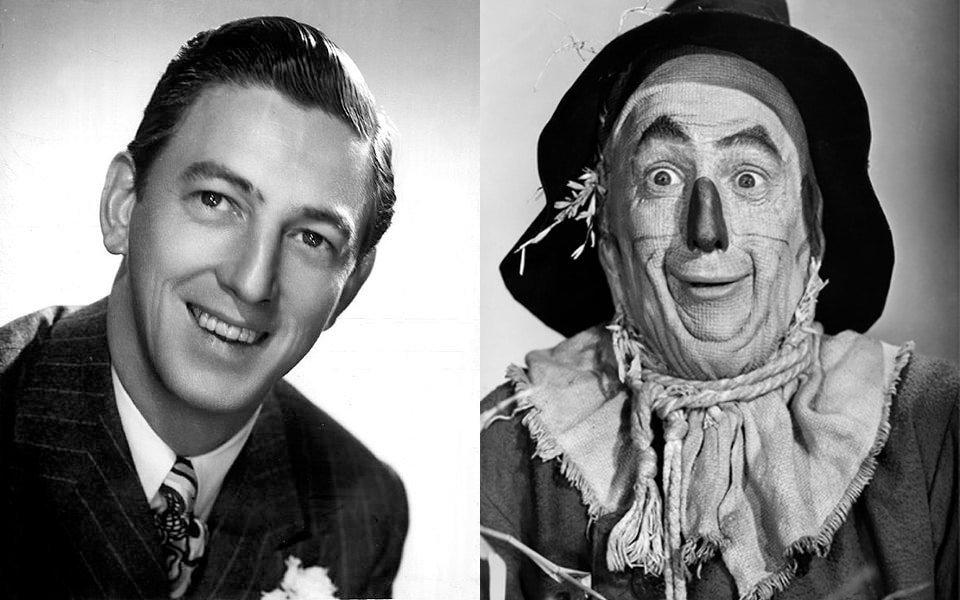
Though designed specifically for Bolger’s face the consistent donning of the mask left marks on the actor’s face that remained noticeable up to a year after filming had ended.
Jack Haley As The Tin Man
After the debilitating poisoning of the original Tin Man, Buddy Ebsen, Jack Haley was hired to take over the roll. Not wanting to duplicating the experience of poisoning one of their actors the MGM makeup department switched from using aluminum powder to using aluminum paste on Jack Haley’s face.
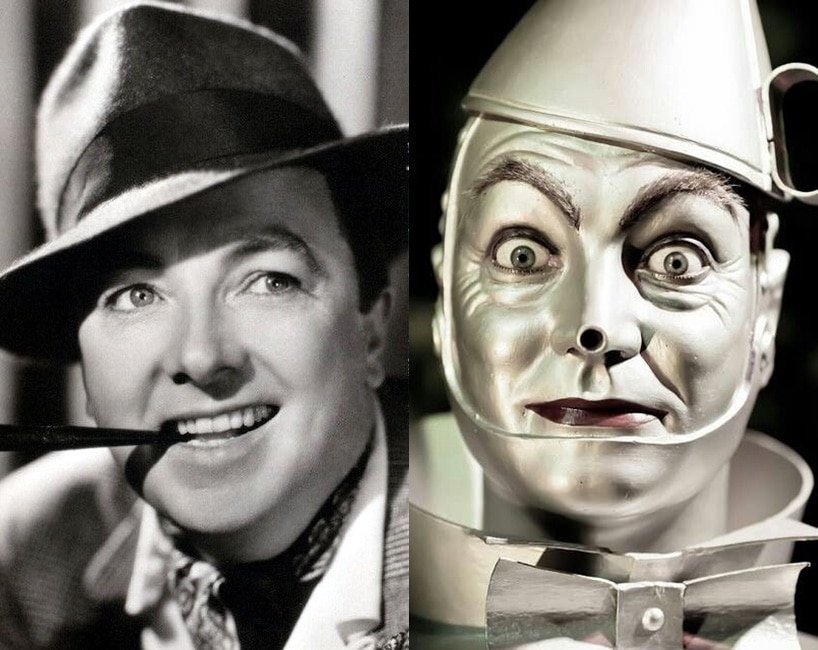
While Haley’s lungs were safe, and he avoided the severity of Ebsen’s allergic reaction, he still fell victim to a rather serious eye infection that required surgical treatment and put all of shooting on hold for 4 days.
Bert Lahr As The Cowardly Lion
The Cowardly Lion, and the actor Bert Lahr, brought like and comedy to the often plagued set of The Wizard of Oz. A comic, both lovable and down to earth in real life, was the first, and the successful choice to play the Lion. Yet, just as his costars Bolger and Haley suffered through makeup and costume problems, Lahr had his own issues to attend to.
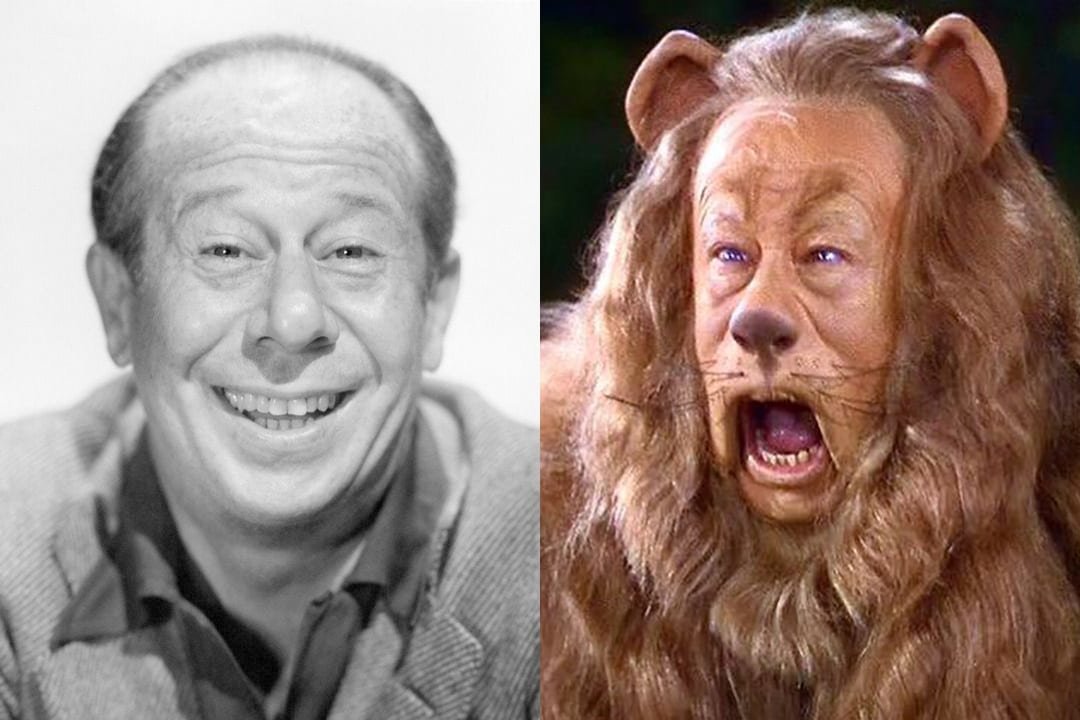
Lahr had no fear of being typecast at production’s end. He was a talented performer of vaudeville, burlesque, and Broadway. And, as the man said himself, “How many parts are there for lions?”
It’s A Bird, It’s A Plane, It’s A Balloon!
It is always romantic these days, with crowded airports and stressful travel, to imagine the magic of flying in a hot air balloon. From the Wizard’s own Kansas origins, to Dorothy’s near trip home from Oz, the hot air balloon fits nicely into the rest of the world Baum created and named Oz. Though forced to flee her only opportunity to be spirited away by basket by Tot’s sudden distraction by a cat, the hot air balloon remains a famous symbol of this famous American story.
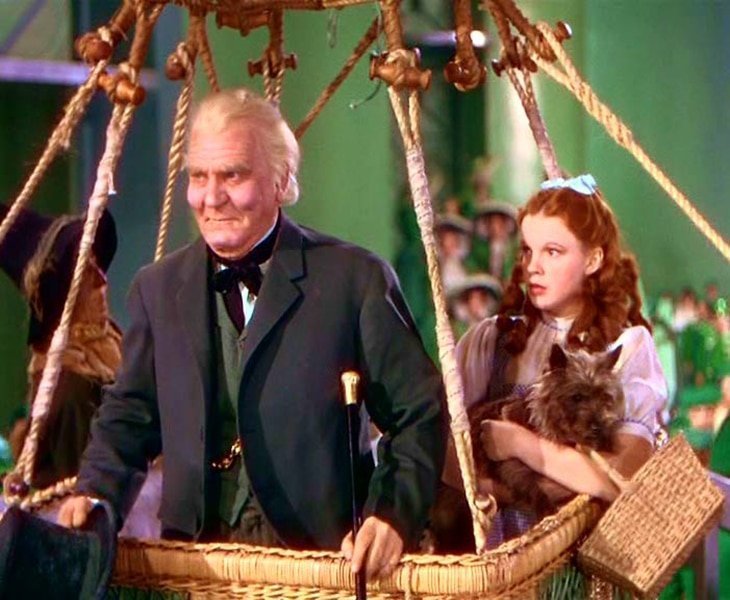
It is only this missed opportunity that allows Dorothy the time to learn she had the power to rescue herself all along. All she needed was MGM’s very bright ruby slippers and the magic words, “There’s no place like home.” Flying in a balloon is magical of course, but self-reliance and friendship is far more magical and useful in the end.
Louis B. Mayer The Studio Spy
As the star, child or not, Judy Garland was a key part of the production of The Wizard of Oz film. It becomes all the more troubling, understanding just how much of a child garland was, when we learn that Louis B Mayer actually hired spies to check in on his star while she was working on set. They watched for any changes in her diet (which was meant to contain nothing but chicken soup, coffee, and 80 cigarettes) and would receive personal reprimands from the studio head if any deviation was found. The spies were told to watch for any consumption of ice cream, in which case extra diet pills would then be prescribed to the young actress.
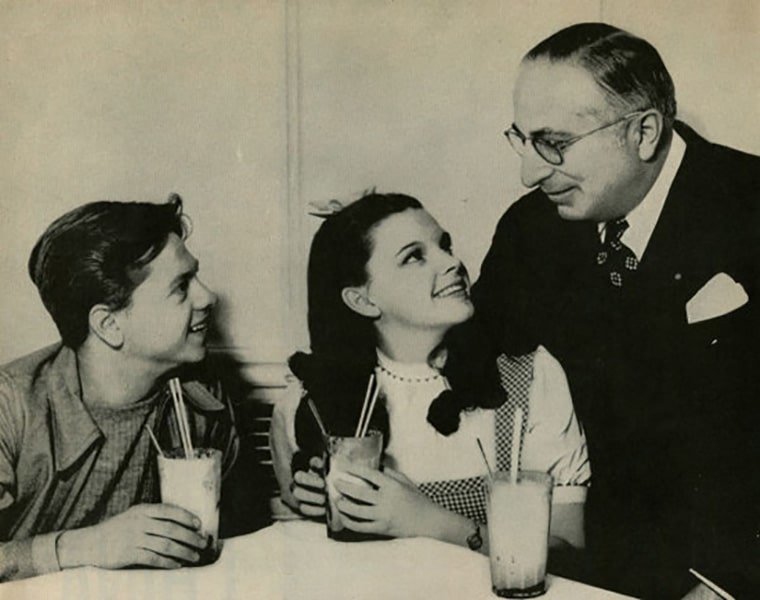
The spying and studio control continued to harm Garland’s fragile self-esteem. Already consumed by thoughts that she was overweight, the extra attention and demands from her male employers further harmed her psychologically. What was meant to be the ultimate moment in a promising career really led to the eventual death of a once promising and hopeful young woman.
The Winnings Of The Wizard Of Oz
The Wizard of Oz is a film known and loved the world over. It is often ranked among the best movies in the history of cinema. Frank Nugent once said of the film, it’s a “delightful piece of wonder-working which had the youngsters’ eyes shining and brought a quietly amused gleam to the wiser ones of the oldsters.”
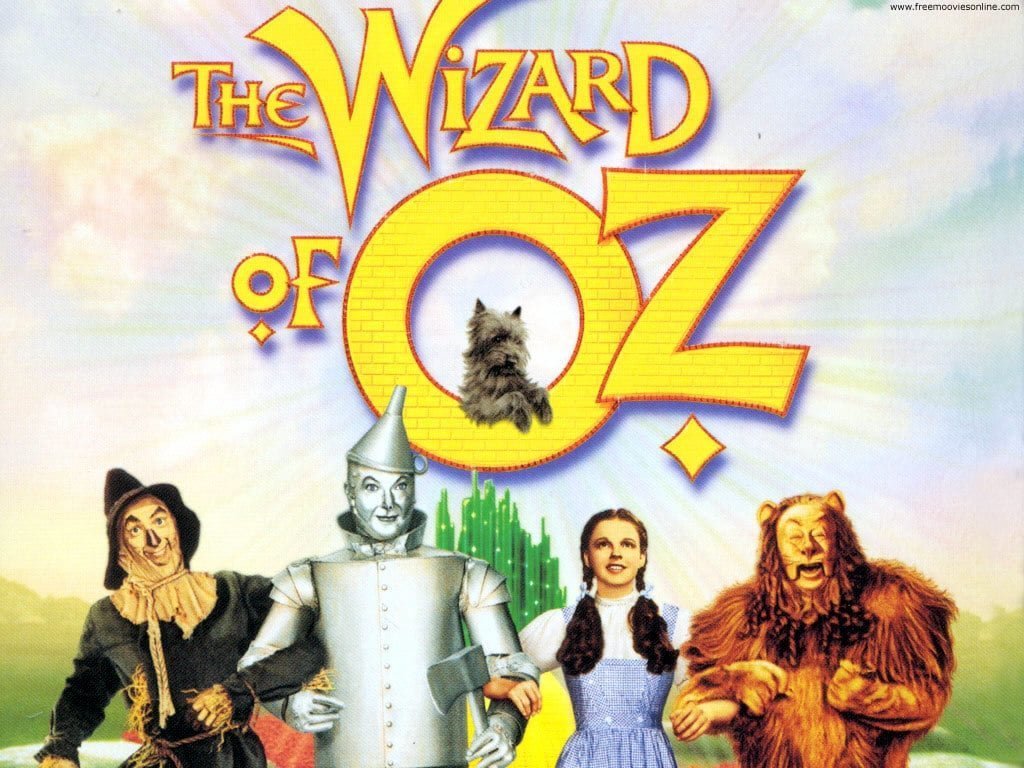
In “Variety,” John C. Flinn wrote of the film, “Some of the scenic passages are so beautiful in design and composition as to stir audiences by their sheer unfoldment.” He wrote of the teenage star, Judy Garland, that she was an, “appealing figure.”
Beyond The Rainbow
Though she would always be tied to the song, “Over the Rainbow,” is seems Judy Garland never quite found the life the rainbow, and the song seemed to promise. She once said, “We cast away priceless time in dreams, born of imagination, fed upon illusion, and put to death by reality.” She lived through countless abuses and tragedies in her life, and yet Garland remains one of the most well known actresses of her age, or any.
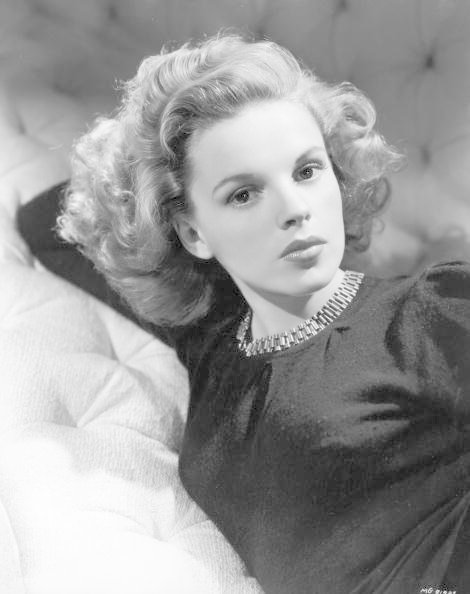
Most of her legacy of course is due to her performance as Dorothy Gale in, The Wizard of Oz. In 1997 Garland was awarded the Lifetime Achievement Award at the Grammys. Many of her songs have since been inducted into the Grammy hall of fame. The award came many years after her death.
Judy’s Liza
Liza Minnelli, daughter of Judy Garland, found fame in show business like her mother. Song and dance were clearly in Liza’s genes. In 1984, Liza was interviewed for New York Times article on her late mother. Garland’s daughter recalled the first time she ever performed with her mother. She recalled how, in that moment, their relationship grew from a loving one to a competitive one.
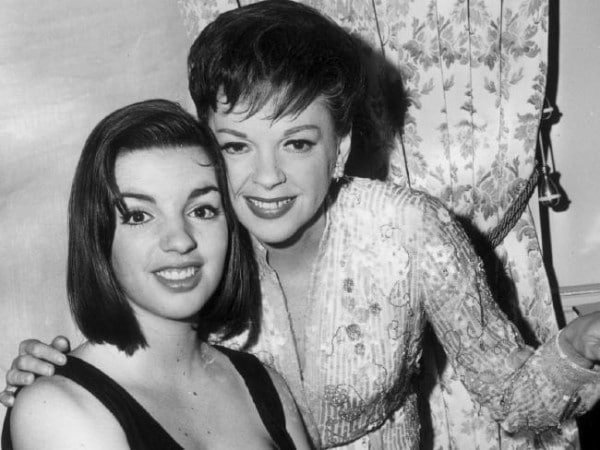
“I think that what Mama was saying was, ‘You’re everything I wanted you to be. You’re a force to be dealt with and I created it, and now I’ve come up against it,” Minnelli said. In a strange coincidence Dorothy Gale’s daughter found herself, for a short while, married to the Tin Man’s son, Jack Haley Jr.
Clara Blandick As Auntie Em
The character of Auntie Em was played by actress Clara Blandick. The part was a relatively small one in the film; it was certainly key to the films larger themes and elements. Auntie Em very much represented the longed for ideal of home and happiness that both Dorothy and, perhaps Judy Garland, shared. Blandick, like Garland, however suffered off set and away from the idealized character she portrayed.
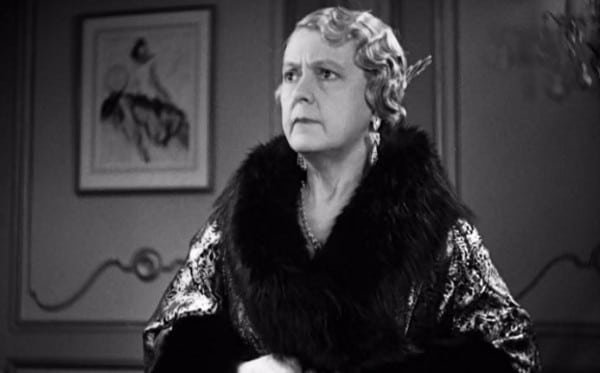
By the 1950’s Blandick suffered from sight loss, significant arthritis, and a severe lack of hope. On April 15, 1962 the actress attended church before returning home and rearranging her bedroom …
Asbestos In The Air
In the famous poppy field scene in The Wizard of Oz, Dorothy, tot, and the Cowardly Lion fall asleep as it begins to snow. The snow, as you may have guessed, was fake. What you probably don’t know is that the fake snow was made up of 100% industrial-grade chrysotile asbestos. At the time of filming it was already known that asbestos came with many health concerns and problems.
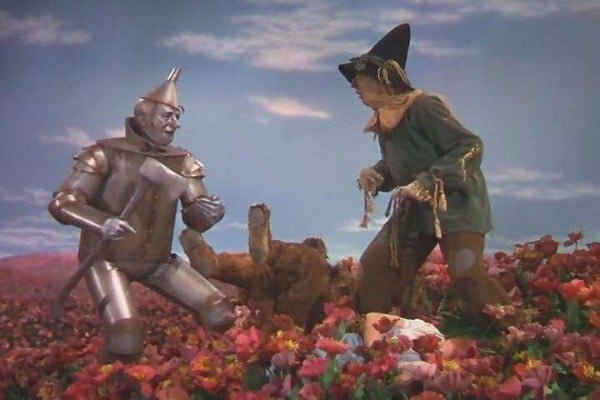
The production used the asbestos despite the known dangers. The evidence about health issues related to asbestos was discovered nearly 40 years before production on The Wizard of Oz even began. While no news ever came out about any of the actors or crew suffering from anything linked to asbestos hazards it’s still not a decision that seems wise in hindsight.
The Wicked Witch As Dorothy
Almost fifty years after portraying The Wicket Witch of the West in The Wizard of Oz, Margaret Hamilton appeared on an episode of “Mister Roger’s Neighborhood,” in 1968. Hamilton discussed with Rogers how she came to play The Wicked Witch of the West. She described the witch as lonely and sad, and how she never did achieve what she so desired.
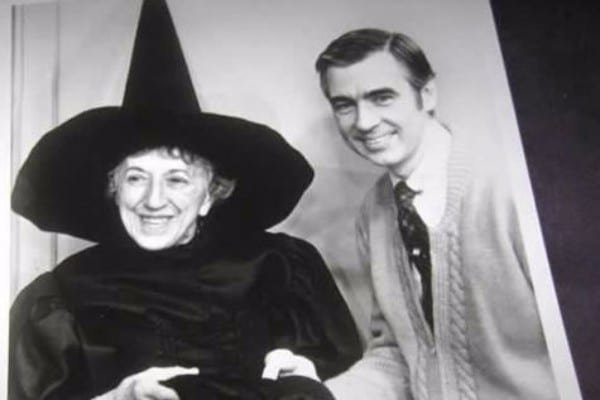
Hamilton also put on some of the original costume to help children understand that costumes and makeup were just pretend, that there really were no real witches, and they should not be afraid. The way Hamilton discussed the Wicked Witch with Rogers is very similar to how the character is portrayed in the more recent Broadway musical, “Wicked.”
Betty Danko The Stunt Witch
After being burned on her hands and face in Munchkinland when the trapdoor refused to open on time, Margaret Hamilton refused to do any more stunts involving fire when she finally returned to set. Another actress, Betty Danko, took over as the witch’s stand in for any scenes involving fire. Originally Dank was only paid $11 a day though her pay rose to $35 a day as she took on more stunts.
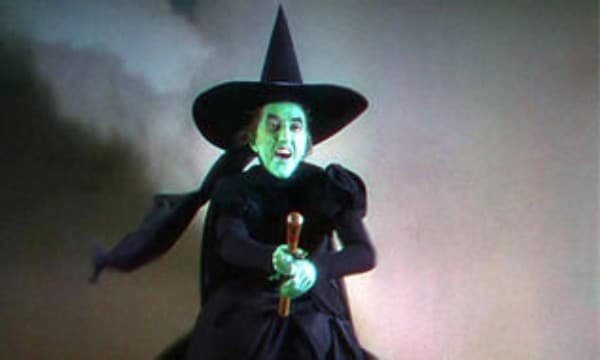
When filming the “Surrender Dorothy” scene, where the witch flies above Emerald City, Betty was also burned. For part of the scene she had to sit on a smoking pipe that was designed to look like the Wicked Witch’s broomstick. The pipe subsequently exploded. Due to her injuries ,Danko was then forced to spend two weeks in the hospital. She received permanent scarring on her legs, but returned to continue doing stunts for the film.
A “Wicked” Musical
In 1995 a novel was written entitled, “Wicked: The Life and Times of the Wicked Witch of the West.” The story tells the story of the coming of The Wizard of Oz from a very different perspective. Instead of hearing from Dorothy, the story of Oz is told from the viewpoints of the witches of Oz, including Elphaba, the Wicked Witch of the West, and Galinda, or Glinda, the Good Witch.
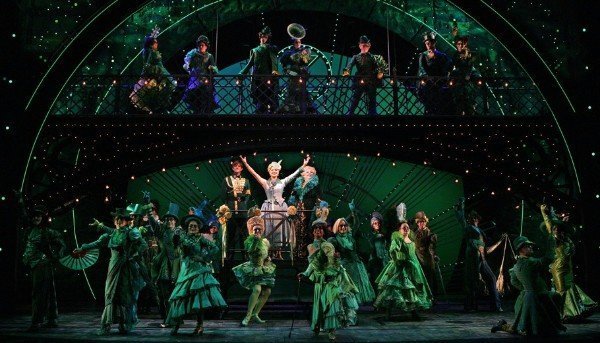
Though the witches begin the story as friends they end up in conflict over the same love interest. The book was made into an incredibly successful musical that focuses on the corrupt government in Oz, and the lies of the great wizard. While Elphaba is scorned publicly, she is seen as the hero of her own story, rather than the evil captor of the helpless Dorothy. The musical premiered in New York in 2003.
The Munchkins, Or “The Singer Midgets”
Most of the Munchkins in The Wizard of Oz were portrayed by a group known as the “Singer Midgets.” They were named for their manager, Leo Singer. The group was actually from Europe. They all traveled to Hollywood for work, of course, but many also used the trip as an escape from increasing Nazi persecution that was spreading across the European continent. Most of the singing the munchkins do in the film was actually dubbed over by professional vocalists.
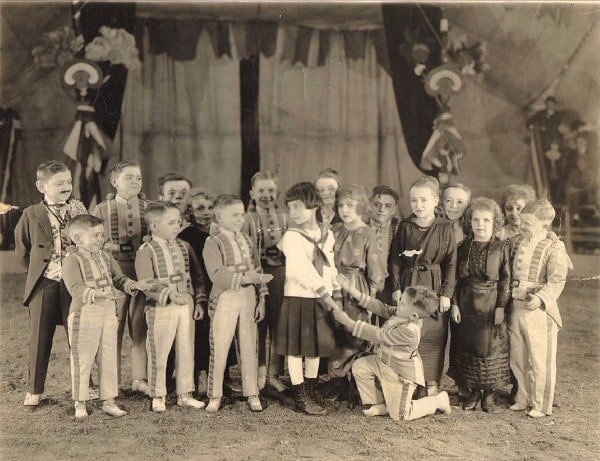
This was especially important, as many of the “Singer Midgets” did not have a strong grasp of English at the time. Only two munchkins are actually heard speaking without dubbing. They are present when the munchkins give Dorothy flowers after she climbs aboard her carriage.
Surrender Dorothy
In the “Surrender Dorothy” scene it was not only a smoking pipe posing as a broom that was used to make the scene work. The words the Wicked Witch traces across the sky were actually drawn in a tank of water and a model of the Wicked Witch herself. The model of the witch was attached to the end of a hypodermic needle and syringe that was filled with milk.
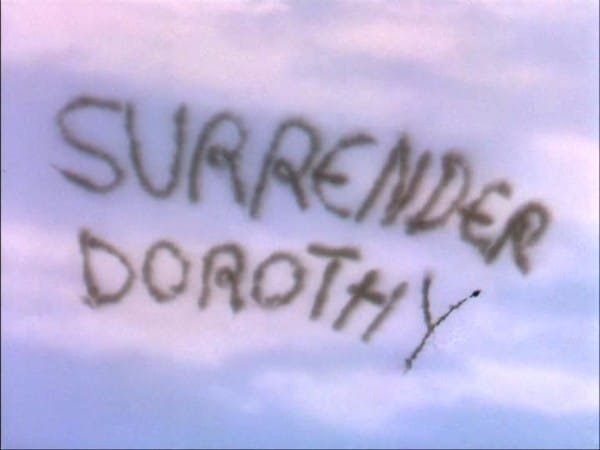
The camera filmed below the tank of water, the tip of the needle was placed in the water and the words were written backwards. Drew Barrymore directed an actual film titled “Surrender Dorothy,” in 2010. It was marketed as a loose sequel to The Wizard of Oz.
Animals In Oz
While there are many animals present in The Wizard of Oz film, notable Toto and the Cowardly Lion, many more were cut from the film, though they do appear in the novel. Remember the Horse of a Different Color? To make those scenes work the horses were covered in Jell-O crystals to give them their bright coloring. The scenes with the horses in Emerald City had to be shot very very quickly because the animals liked to lick the sugary Jell-O off of one another. Animals were very important to the story, so much so, that Terry the Cairn terrier who played Toto was paid more than the Munchkins for her work on the film.
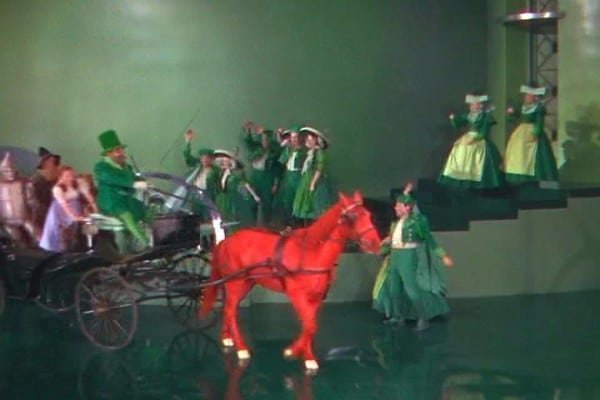
Like the Cowardly Lion, the winged monkeys are played by actors in costumes for the film. The leader of the winged monkeys actually has a name in The Wizard of Oz. He is supposed to be called Nikko. Nikko is a town in Japan that is famous for its shrine that features the original “Hear No Evil, See No Evil, Speak No Evil” monkey depiction.
The Animals Oz Forgot
Some of the animals cut from the film, though enjoyable in the book, were cut because MGM thought the scenes and the animals were too violent. Some of the animals left behind, include Kalidahs, a hybrid of a tiger and a bear, wildcats, wolves, and bumblebees.
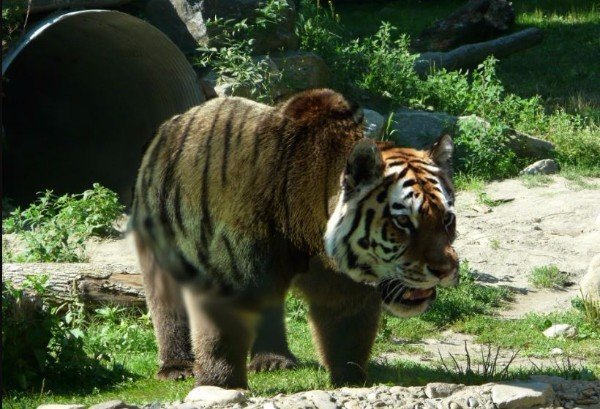
In one scene from the novel the Tin Man actually murders a wildcat and forty wolves with his ax. In a film aimed at families and children this scene, particularly on film, might have been a bit much to include.
Toto The Cairn Terrier
A Cairn terrier named, Terry, played Toto. Cairn terriers are one of the world’s oldest terrier breeds. The breed is originally from Scotland. Cairn is a Scottish word for a man made pile of stones. Oddly enough Cairn terriers are often left pawed. Though Cairn terriers are very popular, having appeared on many shows, including “I Love Lucy, “and “the George Lopez Show,” Toto is probably the most famous Cairn terrier of all.
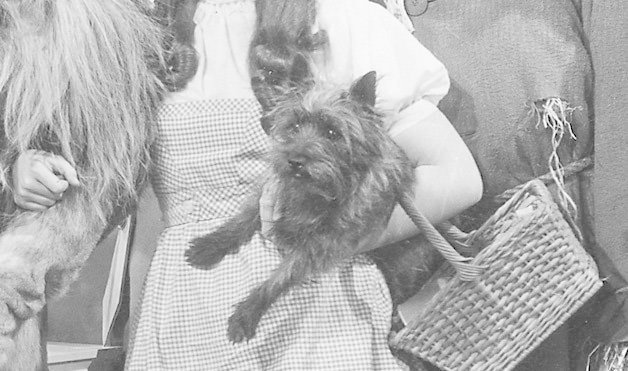
Terry was so popular on set, Judy Garland very much wanted to adopt her costar at the conclusion of filming. But Terry’s owner could not bare to part with her.
Some Very Special, Special Effects
The greens screen and computer animated effects we are used to seeing today were not even a thought when The Wizard of Oz was filmed in 1939. However, everything we see in the MGM Technicolor masterpiece was quite impressive during the time period, though not perfect. Flying monkeys were suspended from piano wire around the set when they needed to “fly” in. More than one actor was injured when a number of wires snapped during the attack scene in the haunted forest.
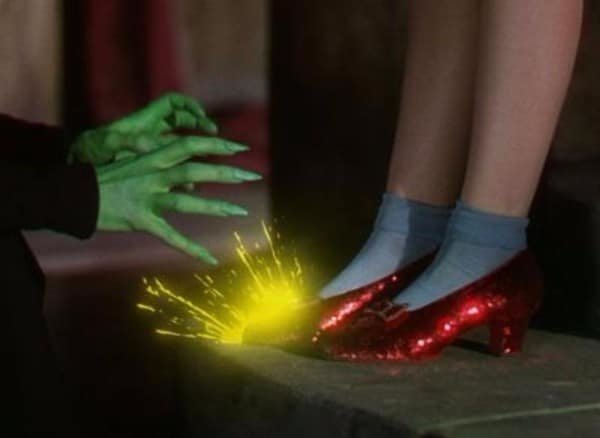
Another impressive feet was when the Wicked Witch attempts to remove Dorothy’s ruby slippers when she is trapped in the witch’s castle. As she reaches to remove the slippers fire jumps up around her hands. This was not real fire, especially with all the burns Margaret Hamilton had already dealt with during filming, but rather apple juice shot out from inside the shoes themselves, and then sped up in post-production. When we see Dorothy’s farmhouse falling from the sky it’s really a miniature model of the house being dropped onto a painting made to look like the sky. The film was later reversed so it looks as if the model house is falling toward the camera. For the Kansas tornado as 35-foot muslin stocking was used and spun through miniature models of the farm and fields.
The Very New Technicolor
Remember when we talked about being able to see reflections of the incredible amount of lights present around the set? During “We’re off to See the Wizard,” you can see shadows from the spotlights and other camera equipment in the surrounding grass. Before The Wizard of Oz most films that used Technicolor were animated. The final product is beautiful, but that didn’t help the actors on set with hundreds of lights and temperatures near 100 degrees.
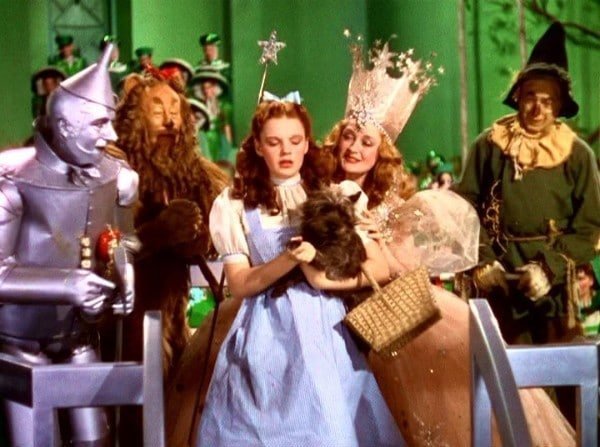
Color also had to be adjust around the set and on certain costumes to make the color look right on the finished film. The white and blue gingham dress we see Dorothy wear in the film was actually blue and pink on set. The original yellow brick road looked green on film in Technicolor and had to be repainted and reshot.
A Spot In The Library
The Wizard of Oz was hugely successful upon its release in1939 and has remained a classic of American film ever since. It was nominated for a number of Oscars at the time including Best Visual Effects, Best Cinematography, Best Production Design, best Picture, and actually won for Best Original Score. Fifty years later the film was recognized for its contribution to cinematic history.
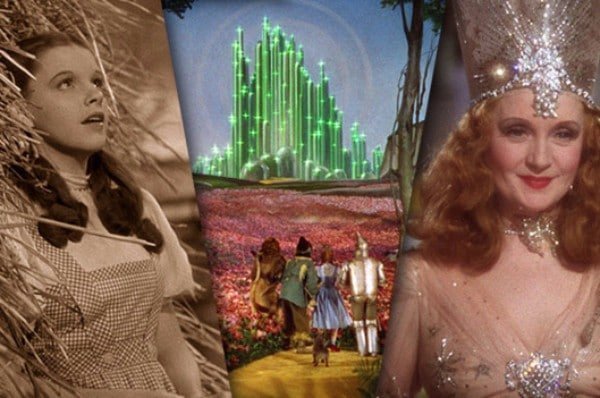
Designated as, “culturally significant,” to the United States of America it was recognized by the United States Library of Congress and is not a part of the National Film Registry. Even more recently, in 2007, Unesco recognized the film, and added it to the list of “Memory of the World Register.”
Pink Floyd
‘The Dark Side of the Rainbow,” is a reference to the pairing of the Pink Floyd Album, “The Dark Side of the Moon,” along with the Wizard of Oz film. When listening to the album while watching the film they seem to pair up so well that it’s as if the two were created together, or at least in conversation with one another. This is purely accidental. However, the pairing does give the film a music video style and is still referred to as “The Dark Side of the Rainbow.” The “connection’ was discovered in 1995 and posted to a Pink Floyd message board. The idea has since reached our popular consciousness in general.
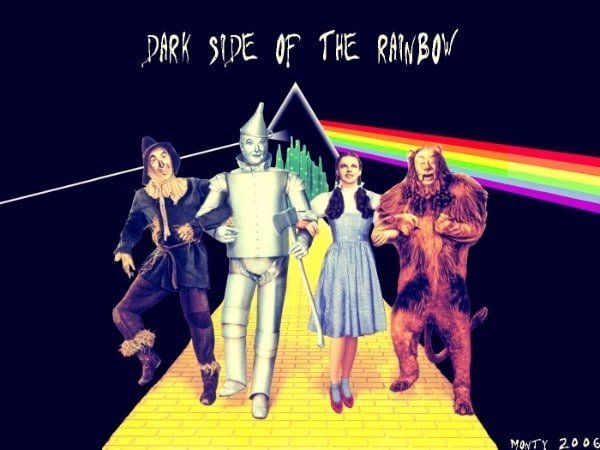
Band members have commented on the connection, and indicated that it is, in fact, only a coincidence. Pink Floyd drummer, Nick Mason, famously joked that the album was never based on The Wizard of Oz but rather on the movie musical, “The Sound of Music.”
The Real Slippers
In The novel by L. Frank Baum, Dorothy’s slippers are silver rather than red. They were turned red for the film, on the suggestion of Louis B. Mayer, due to the film’s use of Technicolor technology. When designers first began work on the famous shoes they had curled toes. Judy Garland, as Dorothy, wore the shoes in a petite size 5. During shooting there were four sets of slippers that were used. Each pair eventually made its way to a museum, including the Smithsonian in Washington DC. One pair however was stolen from a museum in Minnesota in 2005. The shoes at the time were insured for $1 million.
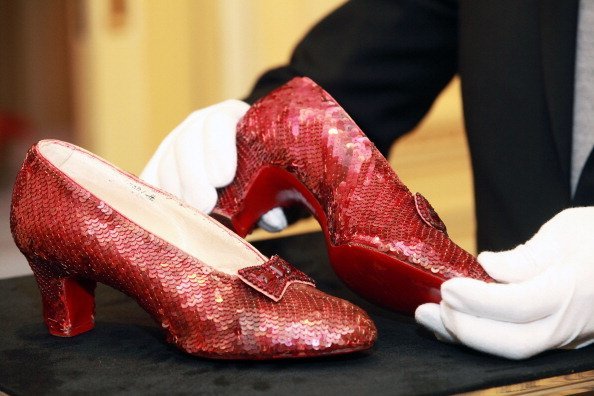
In 1989, for the movie’s 50th anniversary, a pair of ruby slippers was made with real rubies. Those shoes were worth over $3 million. The pair currently on display at the Smithsonian is actually a mismatched set, with one shoe from two different sets used on the movie. Even so, the display of the ruby slippers remains one of the most popular stops for Smithsonian visitors. It’s so popular the museum has to continually replace the carpet around the exhibit.
Oz And Its Author
The Wonderful Wizard of Oz was written by L. Frank Baum in 1900. Before becoming an author Baum was a specialty chicken breeder. He was inspired to write the story of the Kansas farm girl by his own childhood during a drought in South Dakota. He named is heroin Dorothy for a very personal reason. Baum has a niece who died in infancy whose name was, Dorothy Louise Gage. He named his magical world “Oz” almost randomly. He made it up after looking at his filing cabinets which, because they were organized alphabetically, had a drawer marked “O-Z.”
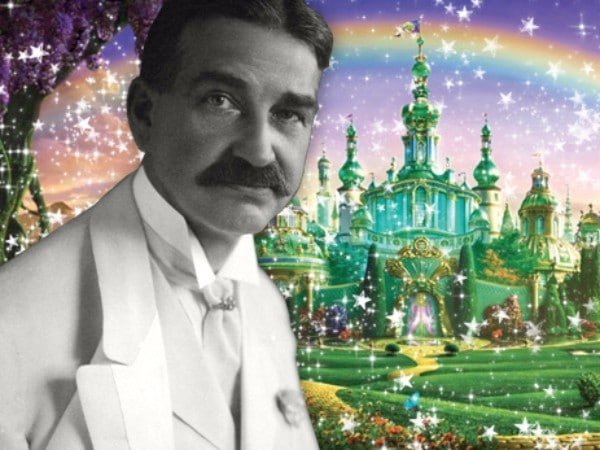
Baum continued to write throughout his life, including nonfiction work on stamp collecting. Just as he hoped his story about Dorothy was feminist, he also supported the women’s suffrage movement. In the end Baum would publish seventeen books about the land of Oz, three of which came out after he passed away, which says a lot about his character. Frank went on to publish even more works about Oz, including 17 sequels with three of them being published posthumously.
Singing About Rainbows
While “Over the Rainbow” is arguably the most recognized song from the MGM film, it was almost left on the cutting room floor. Producers thought the black and white Kansas opening was too long. They also thought the song would be boring to children.
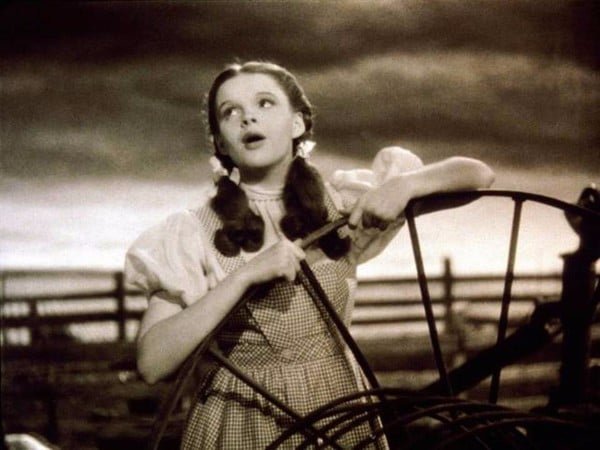
Producers also disliked the location of the song. Dorothy is seen singing in back of her Kansas barnyard, and the studio thought this was an embarrassing place for the character to spend time. A second version of the song was shot in color while Dorothy is captured in the Witch’s castle while thinking about Aunt Em and her home. According to legend the crew became emotional during Garland’s performance. In the end, the original version was kept, and the rest is movie history.
Over The Rainbow And Around The World
Since premiering in 1939 the song, “Over the Rainbow,” has appeared in all sorts of mediums, and in all different versions. In the film Selena, starring Jennifer Lopez, about the life of Tejano music legend, Selena Quintanilla, a scene depicts Selena as a little girl singing “Over the Rainbow,” in her father’s restaurant.
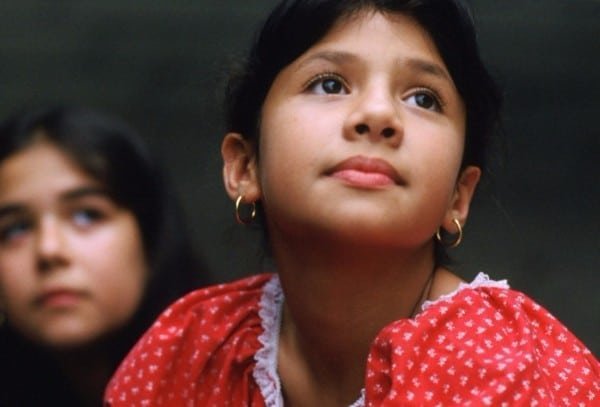
Very much like the tragedy that surrounded the star of the Wizard of Oz, Judy Garland, Selena Quintanilla was also plagued by tragedy, gunned down by a fan at only twenty-three years old.
Not An Only child
Liza Minnelli is the most famous offspring of mother, Judy Garland, but she is not an only child. Garland went on to have two more children with her third husband, Sidney Luft, Lorna and Joey. Lorna also sings like her mother did, and has produced a number of albums. She once played The Wicked Witch of the West in a staged version of The Wizard of Oz, in England’s West End.
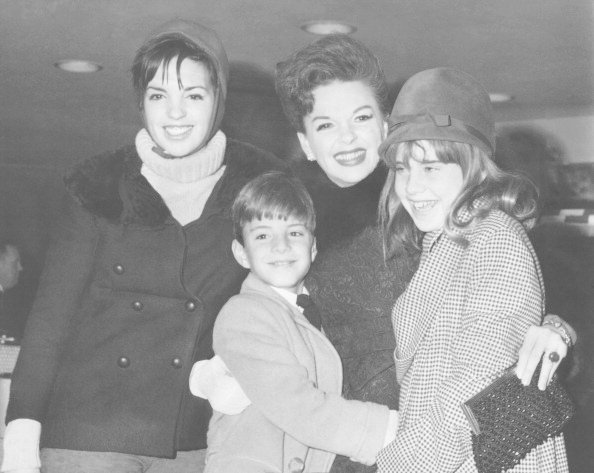
Joey has stayed away from show business, unlike his sisters, though he appears on occasion to discuss his mother, her films, her career, and her life at different events.
The Wizard Played Five Roles
The Wizard, in The Wizard of Oz, was played by actor Frank Morgan. Morgan, magically, not only played the Wizard, but five roles in the feature film. He is first seen as Professor Marvel in Kansas, who claims he can tell the future. He plays the Wizard, obviously, as well as the driver of the carriage with a horse of a different color in Emerald City.
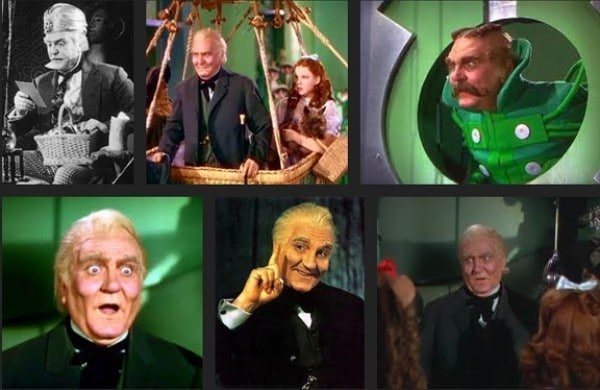
In Emerald City Morgan can also be seen as the doorkeeper of Emerald City, and the Guard at the entrance to the Wizard’s rooms. Perhaps Morgan was just a very talented actor and was looking for more to do on set, since the Wizard appears in so few sense, though some speculate the director wanted the actor, and thus the Wizard, to appear particularly strange and mysterious.
The History of the Wizard, Frank Morgan
Frank Morgan was under contract to MGM studios as part of the old Hollywood studio system. MGM thought so highly of Morgan’s talents that he was actually under a lifetime contract with the studio. He was cast in a large swath of projects, from small comedies, to sweeping dramas, and everything in between. Once, Morgan was even cast as himself in a 1945 film that told the story of his fictional attempt to make his own movie. The project is still considered one of the oddest projects ever taken on by MGM studios.
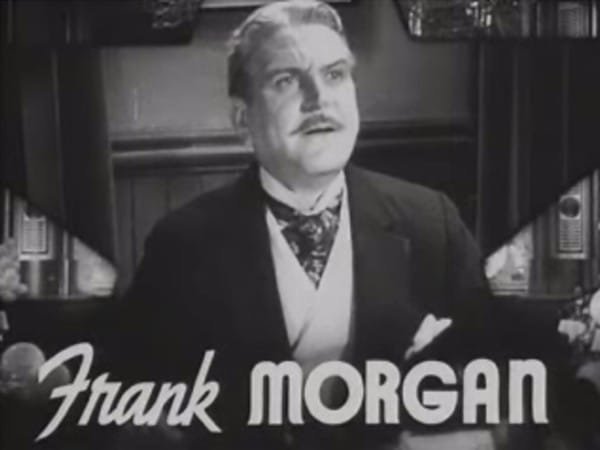
Despite his many talents it has been reported, even by Morgan’s Wizard of Oz costar, Margaret Hamilton, that the actor suffered from alcoholism. The actor passed about a decade after the release of his most famous film, The Wizard of Oz, of a heart attack. With his death in 1949 Morgan never experienced the greater success of the Wizard of Oz once it was made available on television.
Billie Burke As Glinda The Good Witch
Billie Burke was cast to play Glinda the Good Witch in the 1939 MGM production of The Wizard of OZ. Burke was a veteran, having worked in Hollywood since the era of silent pictures. The Wizard of Oz was the second film that found Burke working with Judy Garland, having been cast with her in an earlier film entitled, “Everybody Sing.” In “Everybody Sing,” Burke played the role of Garland’s mother.
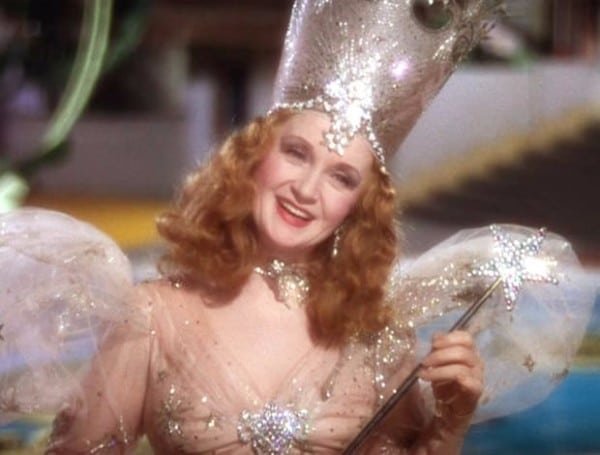
While many might guess that Margaret Hamilton, the Wicked Witch of the West, was older than Glinda, it just so happens that Burke was a full eighteen years older than her evil costar, and found fame as the Good Witch at the age of fifty-four. Burke would live to the ripe old age of eighty-five, and would continue working in film through 1960.
The History Of The Scarecrow
Ray Bolger, the Scarecrow from The Wizard of Oz, began his career in Vaudeville. It was his dancing skills that got noticed and set him up as a success on Broadway before MGM came around to offer the dancing man a contract. While playing the Scarecrow Bolger had prosthetics molded specifically for his face to make the mask he wore as his character. The mask fit a little too well, and a little too snug, and left marks on the actor’s face that took over a year to fully Disappear.
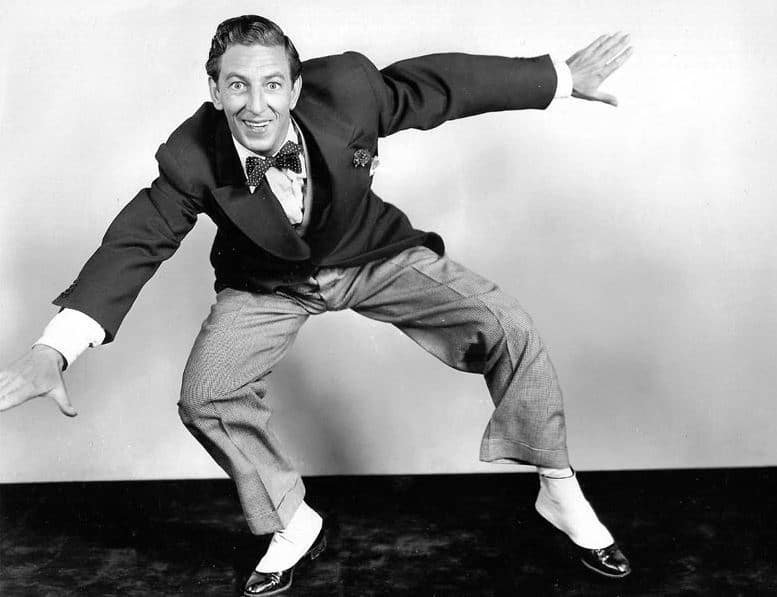
After the success of The Wizard of Oz, Bolger continued acting in MGM pictures including several with his Wizard costar, Frank Morgan. Still acting in the 80’s, Bolger worked alongside Dorothy’s own daughter, Liza Minnelli in, “That’s Dancing!” The actor passed two years after working with Minnelli at the age of eighty-three.
Please Come Play Shirley Temple
As has been stated since the original production began in the 1930’s, Shirley Temple, not Judy Garland, was studio executives’ first choice to play the iconic Dorothy Gale. When the movie was set to begin filming Garland was sixteen, Temple was only eleven. Shirley Temple was an admitted fan of the original book and she was very interested in the role at MGM.
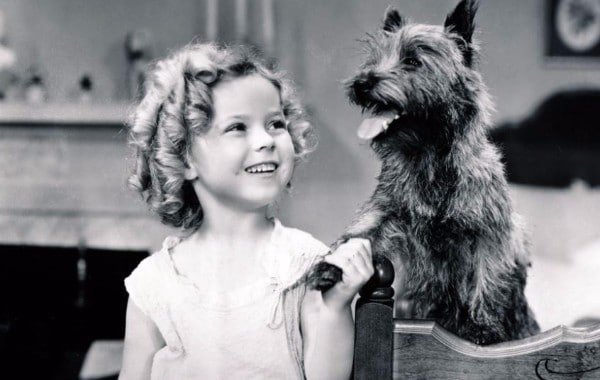
Unfortunately, Temple was under contract to 20th Century Fox at the time. While Fox had informed Temple, and her mother, that they had the rights to make The Wizard of Oz film, MGM ended up outbidding them. And despite interest, studio executives, and a successful filmography, the casting was not to be, and Judy Garland went on to don the ruby slippers.
The Constricting Corset
Upon being cast producers insisted their sixteen-year-old star, Judy Garland, lose twelve pounds before filming. They wanted the teenager to appear younger on screen than she was in real life. They tried giving her blonde hair and special makeup but, in the end, it was only her size they insisted she change for the part.
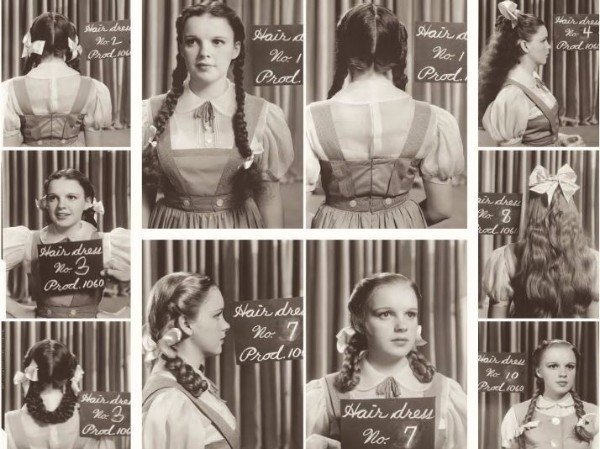
But those twelve pounds weren’t the end for Garland. The studio also insisted the young star wear a corset to help thin her torso and her chest even more. The corset was not only restrictive but also painful for the actress to wear.
Actually A Remake?!
While the 1939 MGM musical is today the most famous film version of L. Frank Baum’s, The Wizard of Oz, it was not the first attempt Hollywood had made to put the book on screen. The Judy Garland version was actually the 10th time an adaption of Baum’s famous novel had been put together. The story has also appeared a radio-play, a silent film version from 1908 that starred Romola Remus, a 15-minute movie from 1910 that was based on another version, a 1902 stage musical.
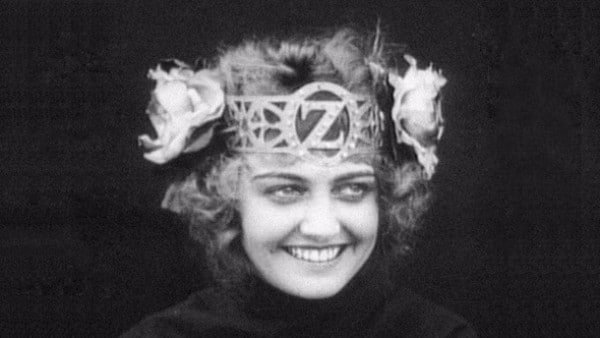
Baum’s own motion picture company, The Oz Film Manufacturing Company, made another of Baum’s books, “The Patchwork Girl of Oz,” into a movie. Rather than following Dorothy, the Scarecrow, the Tin Man, and the Cowardly Lion, the story follows Ojo, Unc Nunkle, and the titular Patchwork Girl.
Other Images Of Oz
Like “The Patchwork Girl of Oz,” another adaption titled, “His Majesty, the Scarecrow of Oz,” also came out in 1914. Then there was “The Magic Cloak of Oz,” which starred a character named Fluff, who was said to be the least happy person in the entire land. In 1925 a man named Larry Semon worked with L. Frank Baum himself on a version of The Wizard of Oz, but it did not hold a candle to what would become the popular 1939 MGM classic.
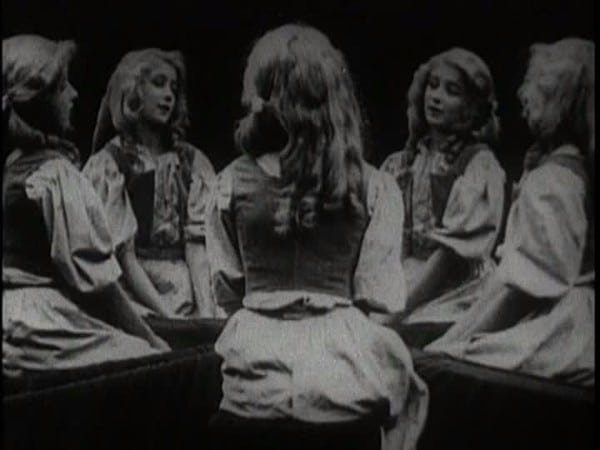
The final version that appeared, before Judy Garland, was an animated picture in 1922. Baum was paid $75,000 for the rights to his most famous work.
It Was A Flop
It’s hard to believe now but when The Wizard of Oz was released in theaters in 1939 in was a box office flop. Today we can look back and recognize that, despite its magnificence, the film was released at the end of the Great Depression, and few people had money to spend at the movies, some movies still did well. “Gone with the Wind,” came out the same year as the Wizard of Oz and was in fact a hit in theaters.
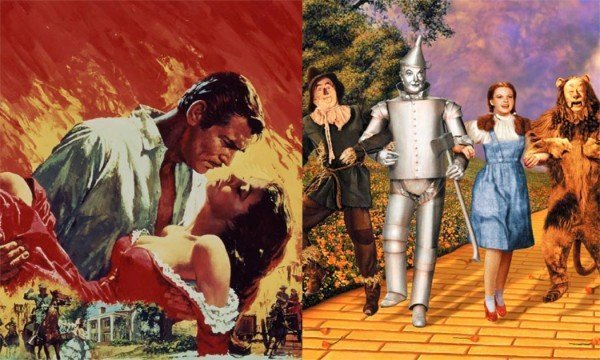
MGM’s Technicolor musical, on the other hand, barely made back what it had cost to make is. The budget of the film was $2.8 million. Despite it’s struggle in theaters the film went on to win two Oscars, one for best score, and one for best original song. The movie didn’t become a real hit until it began playing on television in 1956. It was the very first film that MGM ever aired on a national television network.
Terry The Dog’s Other Films
Terry, or Toto as he is better known, the Cairn terrier who starred in The Wizard of Oz, was a very famous pup, and quite sought after in the Hollywood community. She would go on to appear in ten films over the course of her career. Terry was owned and trained by a man named, Carl Spitz, who took on her training during the Great Depression. While Shirley Temple was not cast in The Wizard of Oz, Terry did go on to work alongside the pint sized star in “Bright Eyes.” Terry worked with director Victor Fleming for a second time on his project, Tortilla Flat, where she also starred alongside the Wizard himself, Frank Morgan, once again.

Terry was also a mom, and her own puppy Rommy went on to work in the movie business as well. Terry lived to 11 and was buried at the home of her owner. Her original resting place was later destroyed by a Highway expansion, though fans can now visit a special memorial to the fuzzy star at the Hollywood Forever Cemetery.
Charley Grapewin As Uncle Henry
It wasn’t only Auntie Em who raised Dorothy; it was also her husband, Uncle Henry, played by Charley Grapewin. Grapewin began his career in entertainment in the circus as a trapeze artist before moving on to perform in Vaudeville, followed by part on Broadway, in silent film, and finally The Wizard of Oz.

Grapewin is also known for his role as, Grandpa Joad, in the 1940’s version of John Steinbeck’s, “The Grapes of Wrath.” Grapewin had a filmography that encompassed a hundred films but, will always be best known for his role, as Uncle Henry in The Wizard of Oz. Grapewin lived to eighty six years old, passing away in 1956, the year The Wizard of Oz premiered on television.
Have You Heard Of Ogden Nash?
Ogden Nash, while not a staple of Hollywood, was a famous American writer and poet. He liked to write puns and use rhymes in most of his writing, which is, perhaps, he was asked to write the first draft of The Wizard of Oz screenplay. In the end no one saw any of the Nash script. MGM instead used a screenplay by Noel Langley, Florence Ryerson, and Edgar Allan Woolf.

While he is not a star in Hollywood many still remember Nash’s other work, he even had a stamp named after him in 2002, about thirty years after his death at sixty-eight, due to an infection and a flare up of his Crohn’s disease.
Have You Ever Seen A Munchkin Fly?
One of the most recognizable of the munchkins in Munchkinland was the Coroner, played by Meinhardt Raabe. At a full three feet and six inches tall, Raabe landed a role that lasted no more than thirteen seconds, and yet his line is one remembered by fans the world over. What Raabe should really be remembered for is his service in the Second World War. He was actually the shortest licensed pilot during the war.

The actor who played the Coroner of Munchkinland was named Meinhardt Raabe. Raabe was three foot and six inches. His role in the film only last thirteen seconds, yet they are a very memorable part of the film. Another interesting fact about this character is that Raabe was once the shortest licensed pilot during World War II. He also earned a Master degree in business administration. He married a cigarette girl who was his height and the two remained married until her death in a car accident in 1997. Raabe lived all the way until age ninety-four. When he passed away in 2010 he was one of the last surviving Munchkin actors.
Oh Romeo
When we meet the Tin Man in The Wizard of Oz he serenades us, and Dorothy, with the classic, “If I only Had Heart.” If you know the song as well as some you are aware that in the middle you can hear a female’s voice ask, “Wherefore are thou, Rome?” Who voiced that famous line in the song? It was the same voice, the same actress, Adriana Caselotti, who played Snow White in the animated Disney classic.

Caselotti continued singing into the 1990’s and even sang, “I’m Wishing,” when Snow White’s Grotto opened in Disney Land, she was seventy-five at the time, and would live another five years before passing away.
A Tale Of A Fateful Trip
Have you ever watched the show “Gilligan’s Island”? One of the main characters was Mary Ann Summer who, according to legend, was based on Dorothy Gale from The Wizard of Oz. Played by Dawn Wells, Mary Ann is said to be from Winfield Kansas, and born on a farm, just like Dorothy. Wells even wore pigtails and gingham on the show, as a nod to the character of Dorothy Gale in Oz.

Well is still alive and still acting at seventy-eight years old. She, along with costar Tina Louise, who played Ginger on Gilligan’s Island, are the only remaining cast members. She even appeared in a web series recently, reprising her most famous role. The show was called, “She’s Still on the Freakin’ Island.”
A Director Inspired
Inspired by Cecil B. DeMille, Mervyn Leroy decided he wanted to be a director after working as a gag writer and silent film actor, including in the early version of “The Ten Commandments.” Mervyn’s career grew until he became head of production at MGM studios. He is also the man who is credited with deciding to make The Wizard of Oz at the studio.

He is also credited with discovering acting icons Clark Gable, Loretta Young, Robert Mitchum, and Lana Turner.
Victor Fleming At The Helm
Victor Fleming was the final, and recognized as the official, director of The Wizard of Oz. In the same year, 1939, he also directed the blockbuster hit “Gone with the Wind.” Both competed against one another at the box office, though “Gone with the Wind” certainly came out on top.

While Fleming continued to direct his two 1939 films are what he is really remembered for. While rumors surround the director’s personal life, including that he was pro Nazi, he did work under MGM head Louis B. Mayer who was himself Jewish.
The Real Life Dorothy
The Dorothy Gale of the Wizard of Oz was named after L. Frank Baum’s real life niece who passed away as an infant. In 1898 Baum’s brother and sister in law had a baby they named Dorothy Louise Gage. She died at only five months old leaving parents and the rest of the family heartbroken. When his niece passed, Baum had just finished his novel of “the Wonderful Wizard of Oz.” He decided to honor his family, and his niece in particular, by naming his heroin after her. The real Dorothy is buried in Bloomington Illinois.

Her grave was rediscovered in 1996. When Mickey Carroll, one of the last living munchkins, heard about it he decided it was time to replace the decaying headstone. It just so happened that Carroll owned his own monument company and, a year later, in 1997, he dedicated the new stone. The cemetery renamed the children’s section of the cemetery the “Dorothy L Gage Memorial Garden.”
A Monkey And His Name
Anyone who has seen The Wizard of Oz can agree that the flying monkeys are particularly creepy, whether they are kidnapping Dorothy or just sitting with the Wicked Witch. What you may not know is that the leader of the winged monkeys actually had a name. In the film he is credited as Nikko. Nikko happens to be the name of a town in Japan. The town is the location of the original “Hear No Evil/See No Evil/Speak No Evil” statue. The statue is a part of the Tōshō-gū shrine.

The monkeys in the statue are supposed to be macaques and, like Nikko in the movie, also have names. They are called Mizaru, Kikazaru, and Iwazaru. The idea of “Hear No Evil/See No Evil/Speak No Evil” is meant to show a person how to present good thoughts, speech, and actions.

You Only Had One Job! The Most Epic Marketing Fails
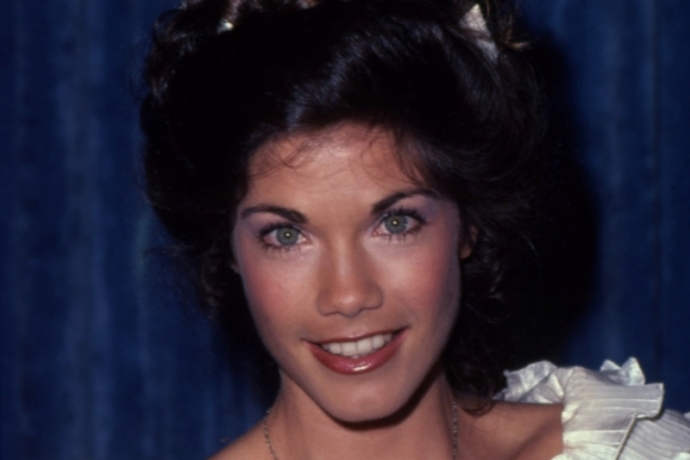
From Dating Hugh Hefner to Winning Life: The Story of Barbi Benton

Piper: Clearing The Runway So You Can Travel

Natural Remedies to Keep Fleas Away From Your Pet
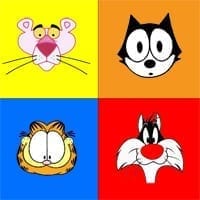
Famous Cats in History
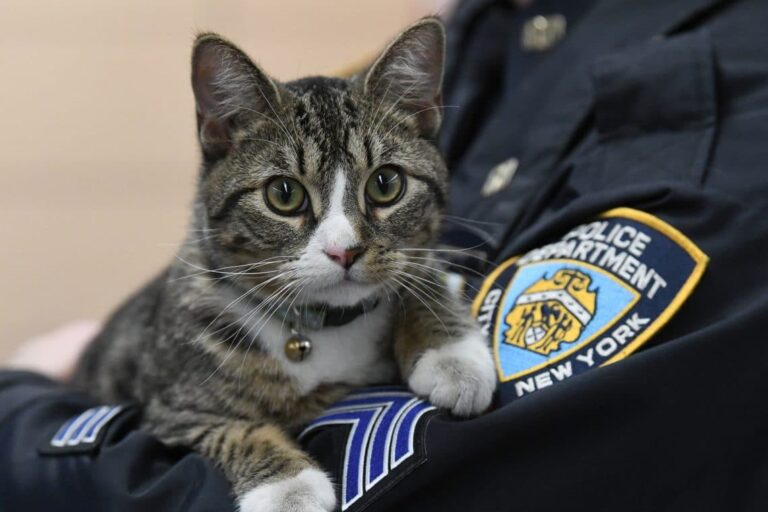
This Kitten Became A Cop For A Day
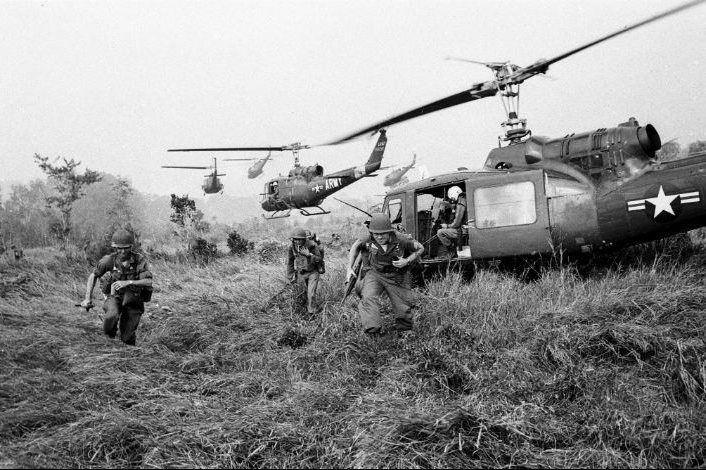
Photos of the Vietnam War: The Real Story
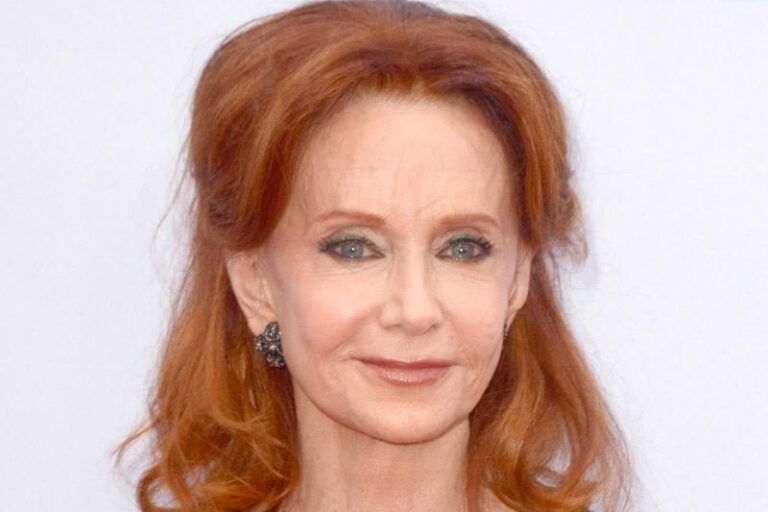
Celebrities Who Served in The Military

Jobs That Pay Over $100,000 That Will Surprise You!

The Lowest of the Low: Waiters Who Got Seriously Short-Changed
